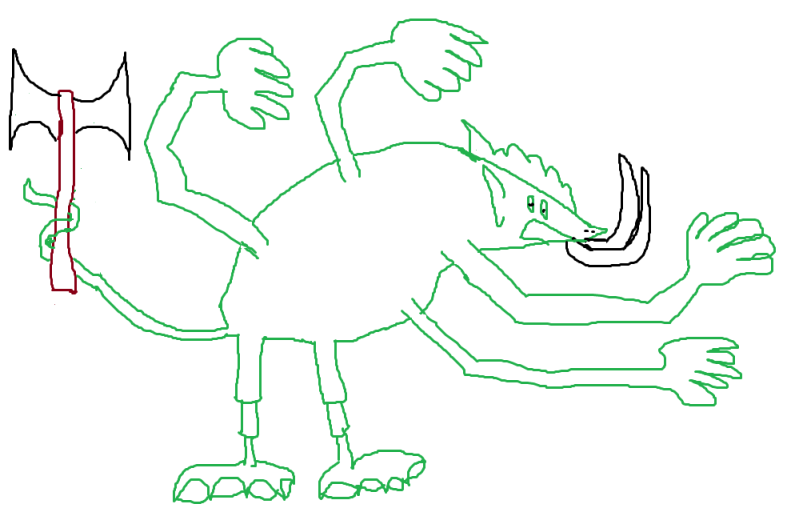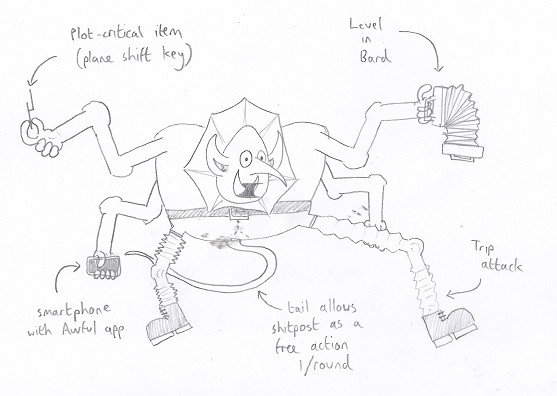Planescape: Monstrous Compendium by SirPhoebos
Baatezu
Original SA post Planescape: Monstrous CompendiumI’m back with my coverage of the Planescape setting. The first book following the campaign box set is the Monsterous Compendium. TSR released 2 more compendiums for the line, but this one is really the one you need. Interestingly, MC1 has a lot of reprints from the core Monsterous Manual, like Baatezu and Githyanki to name a few. I don’t mind the reprinting because it puts the entries a DM is going to be looking up all in a convenient location. On the other hand, whenever a monster gets imported it’s sometimes really obvious that it was not created to fit into the overall setting. I would like to research what entries are new, and where the reprinted ones first originated and if any changes were made, but my initial google search didn’t net me anything.
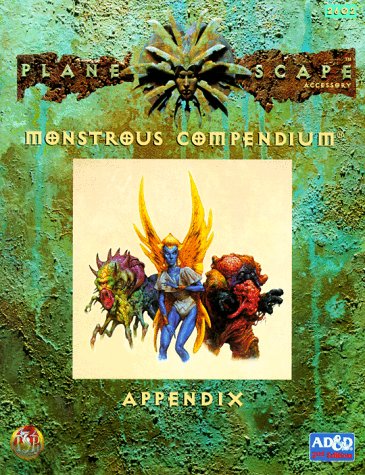
Besides not being done by DiTerlizzi (instead it’s by Jeff Easly), it also shows monsters not in the book. The middle is okay-just an Aasimon. The right guy might be a Bebilith? And I got nothing for Mr. Brains
Rather than go by alphabetical order, I’m going to first cover the main participants of the Blood War: the Baatezu, Tanar’ri, and Yugoloths. They were originally called devils, demons and daemons respectively, and eventually would revert to those names once the Satanic Scare had passed, but I feel that these names are more appropriate in a setting like Planescape. You’re on their home turf-at least show some courtesy to the fiend about to murder you and use your soul to wipe its ass.
After those three I’ll cover all the other mega-groupings in this Compendium - Aasimon, Animal Lords, Gehreleths, Mephits, and Slaad. After them will be the individual entries
Baatezu are the natives of Baator and are the physical embodiment of Lawful Evil. As mentioned in the campaign setting box, the goals of the baatezu are to wipe out the Tanar’ri, and to dominate humanity (yes, it specifically says humanity). Personally, each baatezu is out to promote itself, and while they generally present a unified front, Baatezu will backstab their peers or even superiors if they think they can get away with it Several monsters make up the baatezu race, each connected by a rigid hierarchy. When a Baatezu rises in station, it literally transforms into a different species.
The Baatezu can be subdivided into three subcategories: Least, Lesser and Greater. Baatezu share a number of common properties. Aside from Least, they all have a number of spell-like abilities in common that they can use at-will. The most potent of these is Teleport Without Error, although they cannot freely travel to the Upper Planes or the Prime Material. Another major ability, starting with Spinagons, is the ability to summon other baatezu. Aside from Pit Fiends, this ability only works some of the time, meaning an encounter’s difficulty can swing wildly depending on one role. Baatezu also share a common set of immunities and weaknesses, including taking full damage from silver weapons (or half for Greater Baatezu). Lesser Baatezu can be damaged by +1 magic weapons or better, while Greater Baatezu can be hit by +2 magic weapons or better (save Pit Fiends, who require +3 or better). Lesser Baatezu have 30% Magic Resistance, and Greater Baatezu have 50%. Finally, Baatezu can communicate via Telepathy.
Skurz, and Abishai during his promotion interview posted:
Occupation? Affiliation? Hobbies? It’s one and the same, berk: The Blood War!
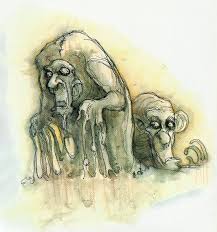
At the very bottom of the Baatezu hierarchy are Lemures (120 xp). Technically, these wretched creatures aren’t even considered proper Baatezu, and are still Petitioners from a mechanics standpoint. They are only Semi Intelligent (2-4), have weak attacks, and almost no defenses. On the other hand, they can regenerate indefinitely, and one needs a Holy item of some sort to permanently destroy one. Baatezu leaders use lemures as big dumb hordes.
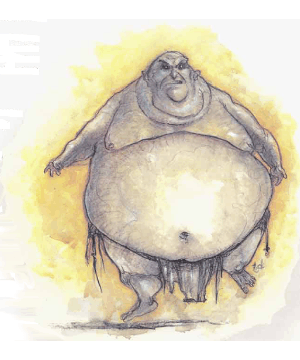
Slightly higher on the org chart are the Nupperibo (120 xp). Mechanically, they are virtually identical to Lemures, although Nupperibo have an intelligence of Non (0), despite both being described as mindless. One interesting piece of fluff is that while they rank higher (as if anyone would care), a Nupperibo cannot be promoted to higher stations without first being demoted down to Lemure. This detail gets revisited in one of the adventure books.
When promoting a Lemure, Baatezu select two and have them fight to the death. The survivor is transformed into a Spinagon, at which point the being is now a Planar. The spinagon-
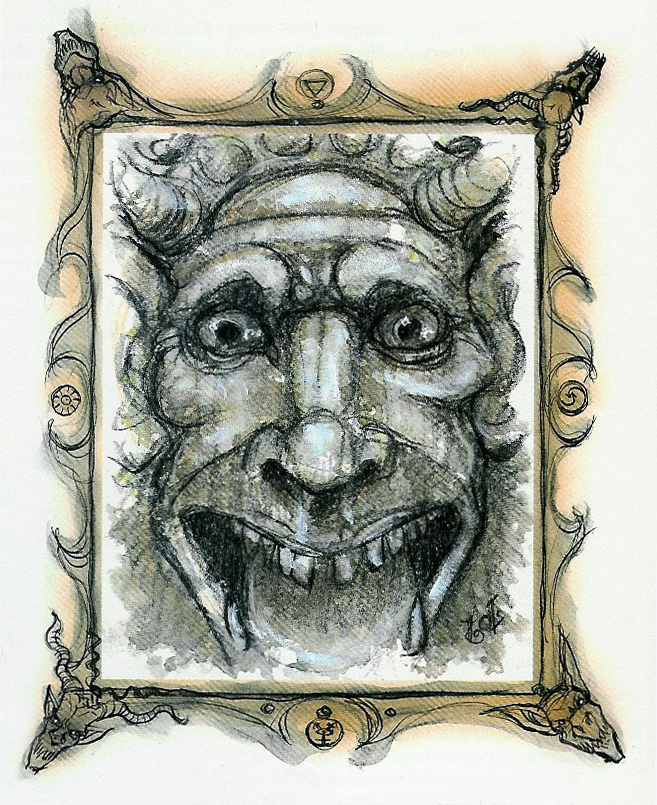
Uhh...I feel like Tony DiTerlizzi sort of phoned it in for this illustration. And it’s not the only one. He does the same thing for the Abishai (which we’ll see later in this post) and the Nabassu (one of the Tanar’ri.) I don’t know what the reason for this was.
Anyway, Spinagon (3000 xp) serve as the messengers and lackeys for superior Baatezu, and act as scouts in the Blood War. They look like small gargoyle-devils. In combat, they can launch up to 12 spines while in flight (2 per round) that burst into flames on impact. A Spinagon’s advancement is decided by those it served, and theoretically can be promoted as high as amnizu. “Stories tell of the pit fiend greth advancing a spinagon to a hamatula.” Most likely though a Spinagon is going to become an Abishai.
(couldn’t find pic in google, but it’s basically the same thing as above)
Abishai are the lowest of the lesser baatezu. The Planescape MC has three varieties of Abishai: Black (7000 xp), Green (8000 xp) and Red (9000). I do remember that these xp values were fixed from the base Monstrous Manual. All three varieties are gargoyle-devils like the Spinagon, but bigger. (My theory for the
 drawings is that TSR sent the same monster description for 4 monsters and DiTerlizzi decided to be passive-aggressive in response). They can regenerate 1 point per round unless damaged by holy water or swords, and their tail attack has a save-vs-poison or die effect. The description says Abishai bestow powerful magics on inexperienced spell-caster, even though they have really weak spell-like abilities.
drawings is that TSR sent the same monster description for 4 monsters and DiTerlizzi decided to be passive-aggressive in response). They can regenerate 1 point per round unless damaged by holy water or swords, and their tail attack has a save-vs-poison or die effect. The description says Abishai bestow powerful magics on inexperienced spell-caster, even though they have really weak spell-like abilities.
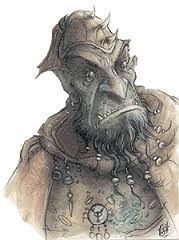
Barbazu (6000 xp) are the next tier of Baatezu, although they take a drop in intelligence (from average down to low). Barbazu serve as shock troops, and typically die in droves in the Blood War. Barbazu can attack opponents with their neck-beard, doing 1d8 damage and has a 25% chance to cause a disease (no details what disease does). Alternatively, Barbazu can attack with a barbed glave, which does 2d6 damage and cumulative 2 bleeding damage per-round per-hit until the wound is bound. Finally, Barbazu have a cumulative 10% chance a round to go into a Battle Frenzy.
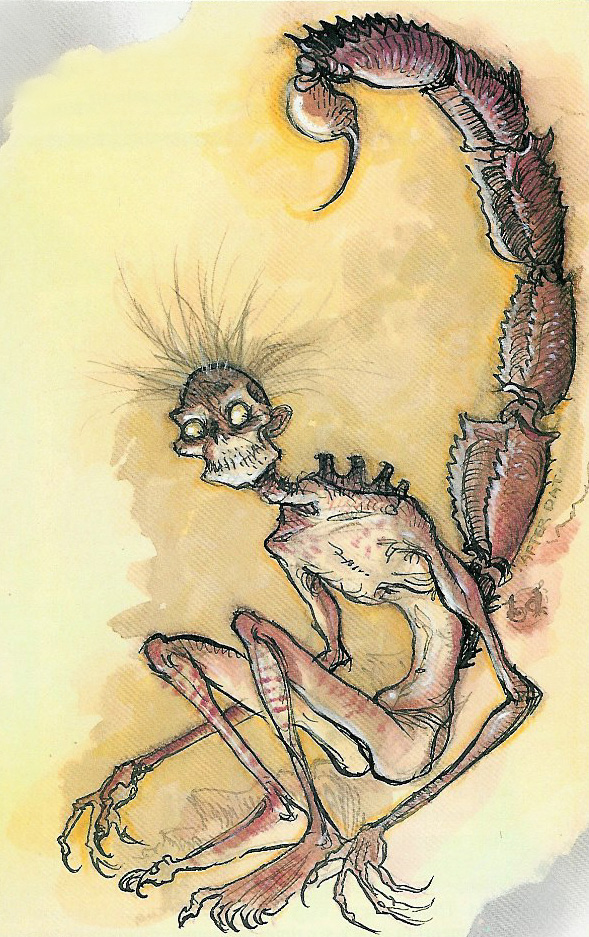
The next rank up is shared by the Osyluth and Erinyes. Osyluth (7000 xp) are the Gestapo of Baator. They have the authority to discipline any baatezu save Pit Fiends, which usually entails getting tossed into the Pit of Flames. In combat, their stinger can do 3d4 damage and injects poison that reduces Strength by 1d4 for 1d10 rounds (-3 on saving throw). Also, starting with Osyluth, Baatezu get fear auras of increasing power (with some exceptions) The fluff section shows clear signs that it was written well before Planescape was conceived, saying that there are only 1,000 Osyluth at any one time (this entry also show poor editing, because just one paragraph above it says there are 100 Osyluth). This seems like a paltry police force for a totalitarian state that has its own Universe to itself.
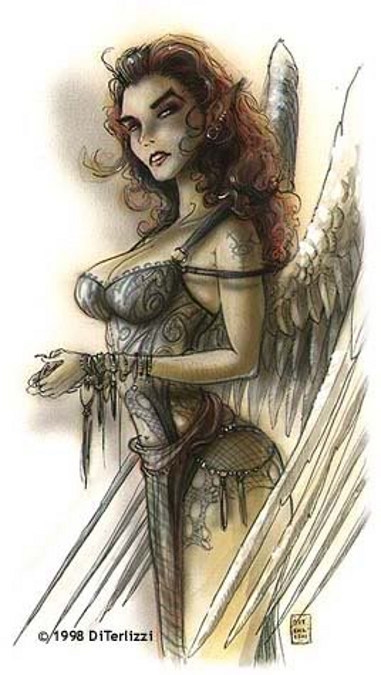
In contrast, Erinyes (7000 xp) are the Lawful Evil version of Succubus. Although they’re all female, they can appear freely as any sex. Erinyes are the only baatezu that can freely travel to the Prime Material, which affords them special status. Because of this Erinyes often refuse promotion, which is...weird that a baatezu has the right to refuse in this instance. Also while Erinyes are Baator’s vanguard in corrupting mortals, there are only 500 ever. Combat wise, Erinyes has a Rope of Entanglement (
 ) and a powerful charm person ability that requires victims to make a spell save at half their level or be totally and indefinitely super-duper loyal to the Erinyes. The main limitation is that an Erinyes can only affect one person at a time. The fluff says Erinyes lure their victim back to Baator, where most likely they’ll die and become a Lemure. A strategy that feels really short-sided, imo.
) and a powerful charm person ability that requires victims to make a spell save at half their level or be totally and indefinitely super-duper loyal to the Erinyes. The main limitation is that an Erinyes can only affect one person at a time. The fluff says Erinyes lure their victim back to Baator, where most likely they’ll die and become a Lemure. A strategy that feels really short-sided, imo.
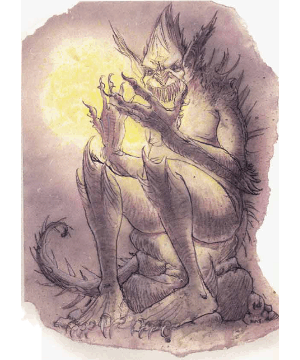
The highest ranked lesser Baatezu are the Hamatula (6000 xp) who serve as solitary patrollers on the third and fourth layers of Baator. Their main combat gimmick is to grapple opponents when both claws hit and impaling them on their bodies. Because they are patrollers they can never be surprised. Unlike other Baatezu, Hamatula cannot travel between layers. Scholars believe this is to prevent them from wandering off (Co-incidentally, Hamatula have 11-12 Intelligence). Finally, there’s info on how Hamatula can be harvested for magic item components. As I said, it’s obvious these were not written with the Planescape setting in mind.
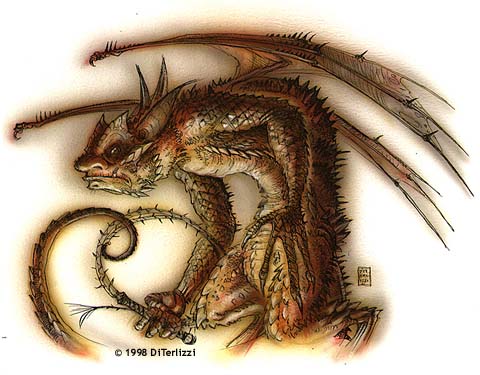
Cornugon (10000 xp) are the lowest rank of greater baatezu, and is also the one gargoyle-devil DiTerlizzi bothered to fully draw. Depending on what layer they’re on, Cornugon either are generals over lesser baatezu or fill out the personal armies of Pit Fiends. Cornugon have a few worthwhile spell-like abilities, such as Wall of Fire 1/day. The crunch text specifically states they have 18/00 strength. Their tail attack can cause bleed damage. Alternatively, they can use their whip which stuns the target for 1d4 rounds (paralyzation save to avoid). Defensively, they can regenerate 2 hp a round (all greater Baatezu except Amnizu have this) Cornugon are very loyal by baatezu standards.
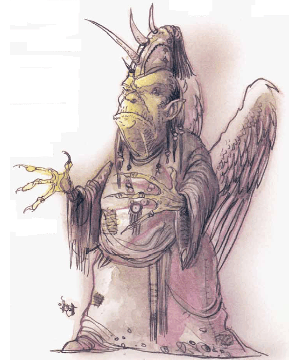
Amnizu (11000 xp) are mainly found on the fifth layer, Stygia, and serve as Baator’s petty nobility - ostensibly loyal but constantly scheming to advance. Amnizu get a touch attack that bypasses normal armor and dex bonuses. It does 2d4 damage and causes the victim to forget one whole day’s memory unless he saves versus spell. One of the spell-like abilities they get is Imprisonment 1/day which they receive because they “protect Baator from invaders”. Amnizu command Stygia’s armies, which consist of thousands of Abishai and Erinyes (remember there are 500 Erinyes in all of Baator. Also they report directly to the Dark Eight).
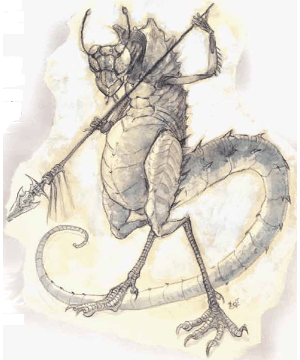
Gelugon (19000 xp) are below only Pit Fiends in rank. They live in frozen Cania, so while the rest of the Baatezu are immune to fire and take 1/2 damage from ice, Gelugon are immune to ice and take 1/2 damage from fire. They have 18/76 Strength. They can attack 4 times a round, (ld4+4/ ld4+4/2d4+4/3d4+4) and their tail can cause paralysis for 1d6 rounds (paralysis save to avoid). 1-in-4 Gelugon carries a spear, which does 2d6 (+4 Str) and can slow for 2d4 rounds if the target fails a Save vs Paralysis. That doesn’t sound like an improvement over going unarmed. Gelugon get Detect Invisibility (always active), something Hamatula and Amnizu don’t get (despite having similar jobs). Gelugon are unique in that they act as both the troops and commanders in their armies; it is unknown how they select their leaders. In order to advance, a Gelugon must serve perfectly for 777 years. That’s the easy part-to actually become a Pit Fiend, a Gelugon enters the Pit of Flames and stays there for 1,001 days. After nearly 3 years of suffering in the pit, the Gelugon emerges as a Pit Fiend.
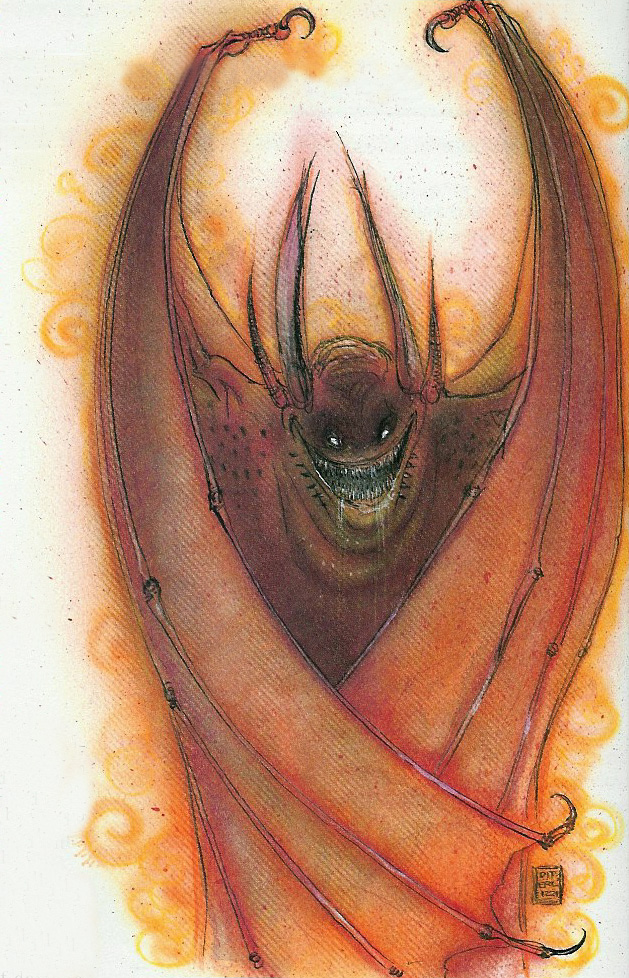
The Pit Fiends (21000 xp) are the leaders of the Baatezu. They have 18/00 Strength and can make 6 attacks a round. Their bite attack forces a Poison Save or the victim dies in 1d4 rounds. Whether or not the save is made, the target of the bite is inflicted with a disease (again, no details on what the disease does). The tail attack, after making a hit, can constrict its victim for the same damage until he or she makes a strength check. Pit Fiends have a potent arsenal of spell-like abilities they can use once per round, including Detect Invisibility, Hold Person, Improved Invisibility, and Wall of Fire. In addition to those it can Gate in 2 Lesser Baatezu or 1 Greater Baatezu once-per-round without fail. To top those abilities off are Symbol of Pain, which it can cast once per day, and Wish, which it can use once per year. When not in Baator, Pit Fiends lead large armies of Baatezu across the Lower Planes. Any non-native to the Lower Planes with less than 10 HD that see these armies flees for 1d3 days (those with equal or greater than 10 HD must make a SRorW Save or flee for 1d12 turns. The most important Pit Fiends in Baator are the Dark Eight, who operate out of the fortress Malsheem in Baator’s lowest layer. The Pit Fiend entry does mention that “It is rumoured” that there are beings in Baator even more powerful than Pit Fiends, but no further details are provided in the Planescape MC.
Next Time: We did snake-tits first
Tanar’ri
Original SA post
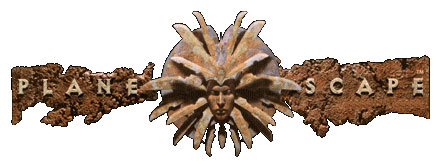
Planescape Monstrous Compendium: Tanar’ri
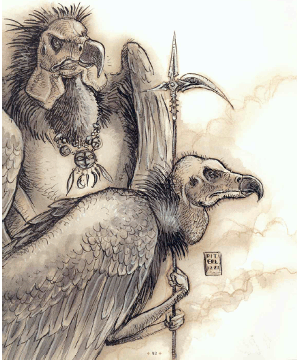
Like the Baatezu, the Tanar’ri are a group of monsters that share common qualities. They are native to The Abyss and are That Player in monster form. So they probably smell like cat piss. Overall their motives are similar to the Baatezu (kill the other guys, and tempt mortals to act like us), but unlike the Baatezu they have no overall structure. In fact they fight amongst each other as much as they fight their mortal enemies. It’s really just the True Tanar’ri that care about the Blood War. If the Baatezu war machine is a Korean pro-Starcraft player, the Tanar’ri forces are a pubbie Molten Core raid circa 2005. This is offset by the Tanar’ri outnumbering the Baatezu 100 to 1.
One Vrock to another upon sighting the next attackers posted:
*smack* Nupperibo! I just love Nupperibo! *smack*
You can tell that the intro to the Tanar’ri was freshly written for Planescape (the rest of entries are imports-you can tell because there’s no acknowledgement of how quixotic it is giving Chaotic Evil fiends specific roles in Tanar’ri society). For one, it opens with an in-setting blurb (tl;dr-The Abyss is terrible). It also notes that the 5 categories of Tanar’ri, holdovers from 1st Edition, mean little to the Tanar’ri themselves. Like my Baatezu write-up, I’ll be discussing the different types of Tanar’ri from weakest to strongest.
- Least: Manes, Dretch, Rutterkin
- Lesser: Cambion, Alu-Fiend, Bar-Lgura, Succubus
- Greater: Nabassu, Chasme, Babau, Wastrilith
- True: Hezrou, Vrock, Glarbrezu, Nalfeshnee, Marilith, Balor
- Guardian: Molydeus
Tanar’ri share several traits. They have a few common spell-like abilities, the powerful being Teleport Without Error. Unlike Baatezu, there’s no restriction on traveling to the Prime Material and Upper Planes (or at least none is mentioned). Like the Baatezu, Tanar’ri can attempt to gate other Tanar’ri once a day, with varying chances of success. Tanar’ri have a number of resistances and immunities, but are vulnerable to cold-iron weapons (Least, Lesser and Guardian take full damage, Greater and True take half damage) and magic weapons (stronger Tanar’ri require stronger bonuses). Tanar’ri magic resistance ranges from 10% to 90%. Like Baatezu, Tanar’ri can communicate telepathically. One thing this section mentions is that any specifically described magic weapon disappears on the Tanar’ri’s death. If it doesn’t disappear, then the fiend got it for somewhere else.
 Warning: A few of these entries are for Tanar’ri-mortal halfbreeds, and all that implies. Also: Succubus in general. It’s not nearly as gross as Cthulhutech, but some might find it
Warning: A few of these entries are for Tanar’ri-mortal halfbreeds, and all that implies. Also: Succubus in general. It’s not nearly as gross as Cthulhutech, but some might find it
 still.
still.
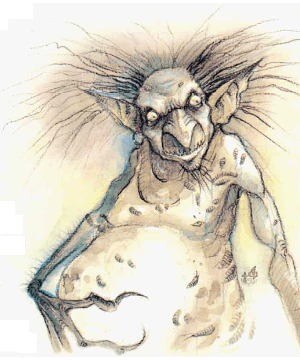
Manes (975 xp) are the weakest of the Tanar’ri, and are technically Petitioners rather than Planars. They’re only semi-intelligent and are used by stronger Tanar’ri as big dumb hordes. They are immune to mind-affecting spells, and their only notable offensive ability is when they die they explode into a noxious mist. Anyone within 10 feet must make a Poison Save or take 1d6 damage. After 24 hours the Manes will reform. The only way to destroy a Manes permanently is to be eaten by another Tanar’ri. If formed into armies, they are given maces, even though they are too stupid to use them. The fluff section says, “[mortals] who were particularly cruel and evil in life are confined to the Pits of Despair on the 400th layer of the Abyss. Of this place, wizards and sages know only the name, because none have ever seen it.”
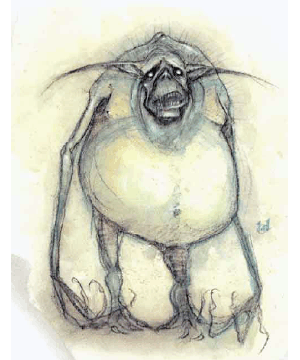
Unlike Manes, Dretch (1400 xp) are proper Tanar’ri. They have enough intelligence to know how much they suck. When in the presence of Greater or True Tanar’ri, they never run away. Dretch get a few spell-like abilities, including Stinking Cloud 1/day. Once a day they can Gate 1d4 Dretch at 50% success, and they do this in an attempt to summon a horde on the spot. Like Manes Dretch often serve as food for stronger Tanar’ri. The fluff says that Dretch “have concern for their position,” which makes them more reliable than Hordelings.

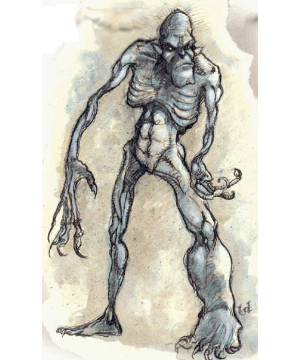
Rutterkin (2000 xp) fight using a variety of strange weapons, which have stats provided in the monster entry. They can attack unarmed, but prefer not to as this causes them pain. Their spell-like abilities include Fly. Rutterkin are outcasts, never impressed into Blood War armies. They patrol the layers of the Abyss attacking any non-Tanar’ri. When they summon others, it raises the alarm on the layer. “The nalfeshnee might create the rutterkin directly from the life forces of evil but incompetent beings who come before them for judgment.” The fluff part also suggests that Rutterkin were originally planes-traveling humans that were enslaved by the Tanar’ri, “who had never encountered beings other than themselves”. You know, despite being at war with the Baatezu since time immemorial.
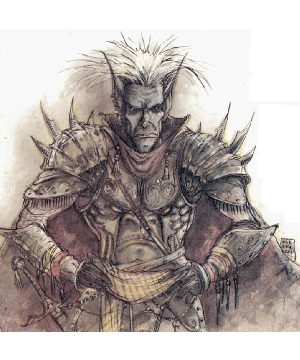
Cambion are the male Tanar’ri-human offspring, and come in two variety depending on the father. Lesser and Greater Tanar’ri father a Major Cambion (4000 xp) while True Tanar’ri father a Baron/Marquis Cambion (6000 xp). In either case the mother dies in childbirth. Cambion get a full set of attributes like player characters. If a Cambion’s charisma is 18 or above, they can use Charm Person at will (or more accurately, produce a reaction identical to Charm Person). Cambions are never surprised, are usually equipped with magic armor and weapons, and have Thief abilities that can be used without armor penalty,and if their intelligence is 16 or above, they can cast spells as a wizard of equal level to their HD (so 4th or 6th level). Cambion serve as assassins in the Blood War, but 1-in-10 Cambion are Planescape-Drizzt because their mother was good-aligned.
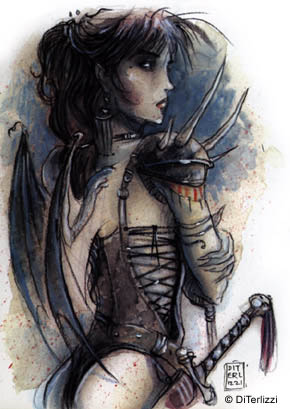
By contrast, Alu-Fiends (4000-6000 xp) are the offspring of a Succubus and human, and are always female. Alu-Fiends can avoid being surprised 75% of the time. Like Cambions they are usually equipped with magical weapons. They can restore their hit points on “a normal melee hit” which does 1d8 damage and restores half rounded up. It’s not clear if the damage replaces or is in addition to weapon damage. Their spell-like abilities include Dimension Door 1/day and Suggestion. 10% of Alu-Fiends have 18 intelligence and can cast magic as a wizard of up to 12th level. Unlike Cambions, other Tanar’ri see Alu-Fiends as lowly and without purpose because of their dual nature. In turn, Alu-Fiends are hateful even by Tanar’ri standards. 20% of Alu-Fiends are CN or N because they had a non-evil dad.
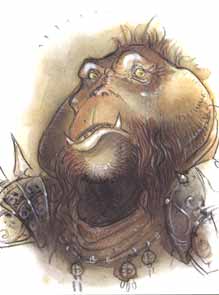
Bar-Lgura (8000 xp) inhabit the jungle layers of The Abyss. They use ambush tactics, and can either camouflage themselves (Hide In Shadows 95%) or as one of their spell-like abilities cast Invisibility twice a day (some Tanar’ri entries, including Bar-Lgura, have the line ‘uses these as an xx spell user. This is not consistently applied). When they attack, they can spring 40 feet and “attack savagely” in the same round, which I assume is exceptional? Another notable spell-like power Bar-Lgura get is Dispel Magic. Bar-Lgura live in tribes, “the only government in the Abyss.” They try to avoid participating in the Blood War or the rest of The Abyss. In fact, the entry says they’re “the closest thing to animals among the tanar’ri.” When they do get shanghaied into Blood War armies, they serve as scouts.
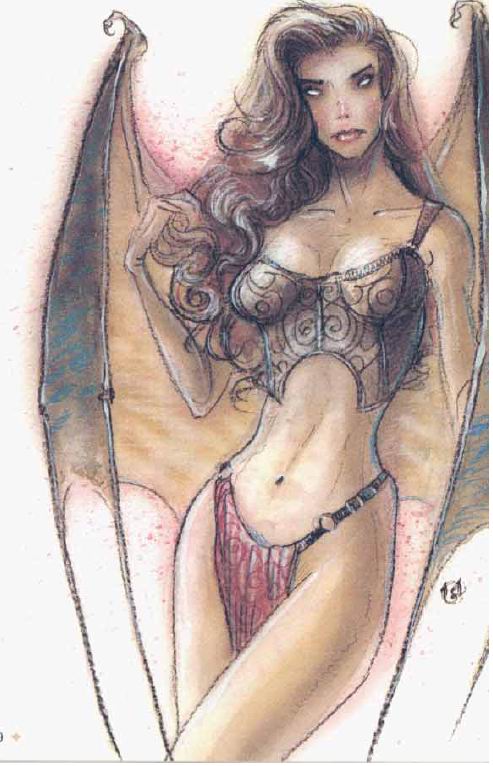
So, Succubus (11000 xp). To 2nd Edition’s credit, this entry does mention that Incubus are also present, but are far less common. The reason is unknown, but “Sages suggest that mortal men are far more susceptible to the temptations of beauty than are women.” Well, okay, at least that’s given as an in-setting theory. They usually polymorph into human or demihuman form, but “they do not often deal with demihumans, because humans’ fiery nature makes them easier prey.” Their main ability is Energy Drain. I’ll just quote the book on this:
Combat posted:
The kiss of a succubi drains energy from its victim, causing the loss of one level of life energy. The succubus lures a mortal man into activities of passion and then drains energy from him. Even after a drain, the heat of the moment is so strong that most men do not notice (Wisdom check at -4 penalty to notice each drain). If he fails the check, he continues, heedless of danger.

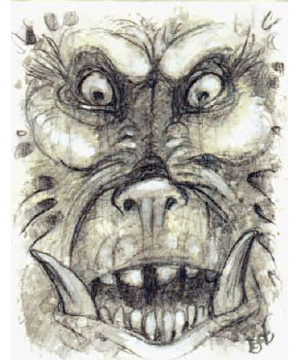
Another gargoyle-devil (um, -demon), another portrait. Nabassu come in two varieties. Fledging (8000-11000 xp) and Mature (16000 xp). Nabassu spawn in the Abyss, but they grow and gain power on other plains by killing humans. The entry gives the mechanics for how Fledgling Nabassu mature, because that is something a DM will keep track of. Fledglings don’t get the standard Tanar’ri spell-like abilities, but they get a death gaze 1/day. The target has to make a Spell Save or turn into a ghast (or ghoul if demihuman) over 1d10 days. Killing the Fledgling or Remove Curse will reverse the process if it hasn’t reached maturity. Fledglings also get thief abilities, including 2x backstab. At maturity, a Nabassu loses the Fledgling abilities, but gains the standard Tanar’ri Suite as well as some new abilities, including Energy Drain (by touch). While in The Abyss, Mature Nabassu can automatically summon 2-5 ghasts once per day. Any living creature coming within 10 feet must make a Paralyzation Save or be paralyzed for 1d10 rounds (once per encounter). Both Fledglings and Mature Nabassu have 19 Strength. Nabassu have no role in the Blood War. Once they return from the Prime Material, they live in a fortress for all eternity.
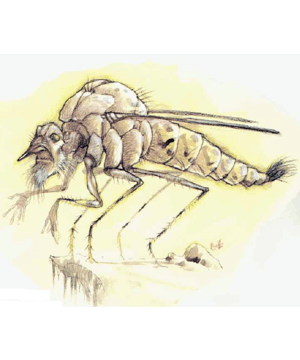
Chasme (14000 xp) search for Tanar’ri trying to evade participating in the Blood War. Wounds from their claw attacks can victims to bleed profusely (2 hp/round until magically healed). Chasme also get a weirdly worded ability that can put living creatures to sleep (Spell Save to avoid). Chasme’s ability to blood drain is tucked into the description. Chasme have an always-active Detect Invisibility and Detect Good, and can also cast Ray of Enfeeblement once a round. Chasme can somehow tell if a Tanar’ri has gone AWOL, and punish them with murder. Chasme reproduce from eggs, and I’m disappointed that they aren’t laid in deserters or something. Oh, and Chasme Wings can be used to make Potions of Flying.

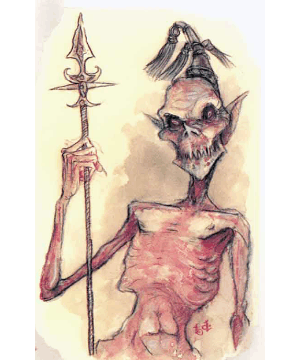
Babau (17000 xp) recruit Lesser and Least Tanar’ri for the Blood War. Which is totally different from what Chasme do. Babau get a Ray of Enfeeblement gaze attack. They use weapons (20% chance of being magical) and have 19 Strength. Their skin is covered in a corrosive oil that halves Slashing and Piercing damage and has a chance of ruining normal weapons or reducing the bonus of a magical weapon. Babau get Thief abilities (including backstab x4), and some useful spell like abilities. In addition to the chance to summon weaker Tanar’ri, there’s a 20% chance a True Tanar’ri will come to their aid when attacked.
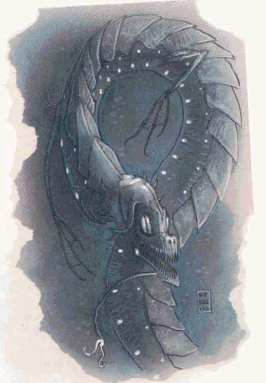
Wastrilith (19000 xp) I strongly suspect weren’t originally Tanar’ri before this book, because the description says they inhabit the watery parts of the Lower Planes, and “rarely” other planes. I put that in quotes because the rules provided are focused on encountering one in a normal setting. They use minions to fight, which include sharks, sahuagin, water elementals, and ixitachitl. Wastriliths themselves can use a breath weapon attack 3 times a day, and when facing water elementals, have a 50% chance of wresting control of them from the summoner. Most of the fluff talks about what Wastriliths do on the Prime Material, and there’s just one line that says that many live on the 88th layer of the Abyss.
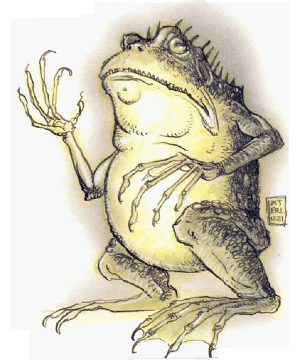
Hezrou (14000 xp) oversee the formation of armies on the Abyss. Hezrou can never be surprised, have 120 feet infravision, and “have double human normal auditory and olfactory senses.” If a Hezrou hits an enemy with both claws, it bear hugs them and does 2d4 damage a round and their bite attack (4d4) automatically hit. The victim must make a Strength check at half their score to escape. Anyone within 10 feet of the Hezrou must make a Paralyzation Save or be overcome with nausea (no duration given). Their spell-like abilities include Unholy Word and Wall of Fire. In addition, “at certain times in a century” Hezrou can Plane Shift and go make pact with mortals. Hezrou enforce the directives of the Nalfeshnee and other True Tanar’ri, being too dumb to come up with their own ideas.
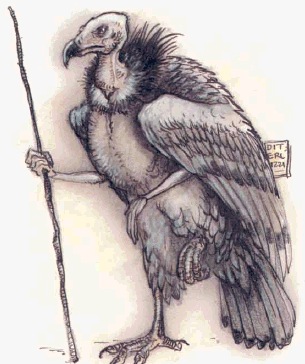
Vrock (19000 xp) are the elite troops of the Tanar’ri. They can never be surprised, always attack first and have 19 strength. They have 5 attacks, and can direct them at different opponents. Once every three rounds, Vrock can shoot out “stringing ejection of spores” that automatically hit every opponent within 5 feet. This causes 1d8 damage plus 1d2 damage per round for the next ten rounds. Once per battle, Vrock can emit a screech that stuns everyone within 30 feet (constitution check to avoid). Aside from individual spell-like abilities, a group of 5 Vrock can get together to perform the Dance of Ruin. It takes 3 rounds, and on completion does 2d20 damage to anyone within 100 feet, including the Vrock (Two saves are given-Death to avoid, Spell to take half damage). There’s very little fluff, just that they fight in groups of 8 and eat their enemies after battle.
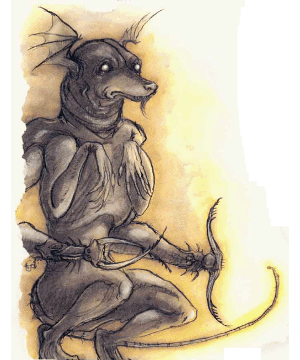
Awwww, who’s a good orgy demon? Yesss you are!
Glabrezu (12000 xp) don’t participate in the Blood War, but instead spread the influence of The Abyss on the Prime Material by tempting mortals with power. That or face licks. If forced into combat, Glabrezu have five attacks, and on successful attacks, they can pick up an opponent “up to 150 pounds”. Glabrezu have a bunch of spell-like abilities including an always-active Detect Magic and True Seeing, Reverse Gravity and Power Word Stun 7 times a day, but the main Glabrezu strength is narrative. Glabrezu have vast hordes of gold and magic items in their lairs in The Abyss, and use these to tempt mortals into summoning them. Glabrezu are content to play the long game when corrupting mortals. They don’t get along well with Mariliths.
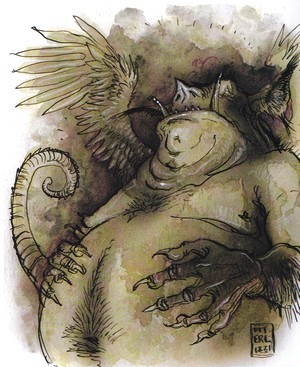
Nalfeshnee (17000 xp) are from the 400th layer, the Mountain of Woe, and judge the souls that pass into the Abyss. They can never be surprised, and their big gimmick is a full round attack that shoots out rainbows that can a set amount of damage and cause victims to wander aimlessly for 1d10 rounds (-2 Spell Save) while they see their greatest fear. They can use this ability 3 times a day. They have a bunch of spell like abilities, many of which are always active (such as Detect Invisibility, ESP and Protection from Good). Nalfeshnee have the highest intelligence of any Tanar’ri (Godlike, or 21+) and feel like they are the bestest Tanar’ri and take every opportunity to show up other True Tanar’ri like Balors. Also:
Ecology posted:
Nalfeshnee feed on hatred and despair, emotions they can draw out of any being they see. They devour these feelings from the life forces they judge, leaving empty husks of useless thoughts. These husks then transform into other forms tanar’ri in ceremonies involving unimaginable torture.
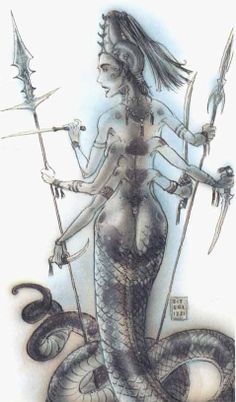
Marilith (23000 xp) are supposed to be the tacticians for the Tanar’ri. I’m picturing this is how their strategies work in practice: https://www.youtube.com/watch?v=0yKqKg6DfTY. Despite being the brains of the war effort, Mariliths love to fight. They can attack up to seven times (six weapons and a tail constrict). Most if not all of a Marilith’s weapons will have a magic bonus of some sort. On top of damage (4d6) anyone caught in the tail constrict must make a constitution check to avoid falling unconscious. Finally a Marilith gets several spell like abilities including Cloudkill and Cause Serious Wounds. The fluff section is self-aware to admit that trying to strategize for Tanar’ri is pretty much impossible. In spite of this, Mariliths believe they are the real leaders of the Tanar’ri. They especially hate Glabrezu, possibly because their role makes sense as opposed to theirs.
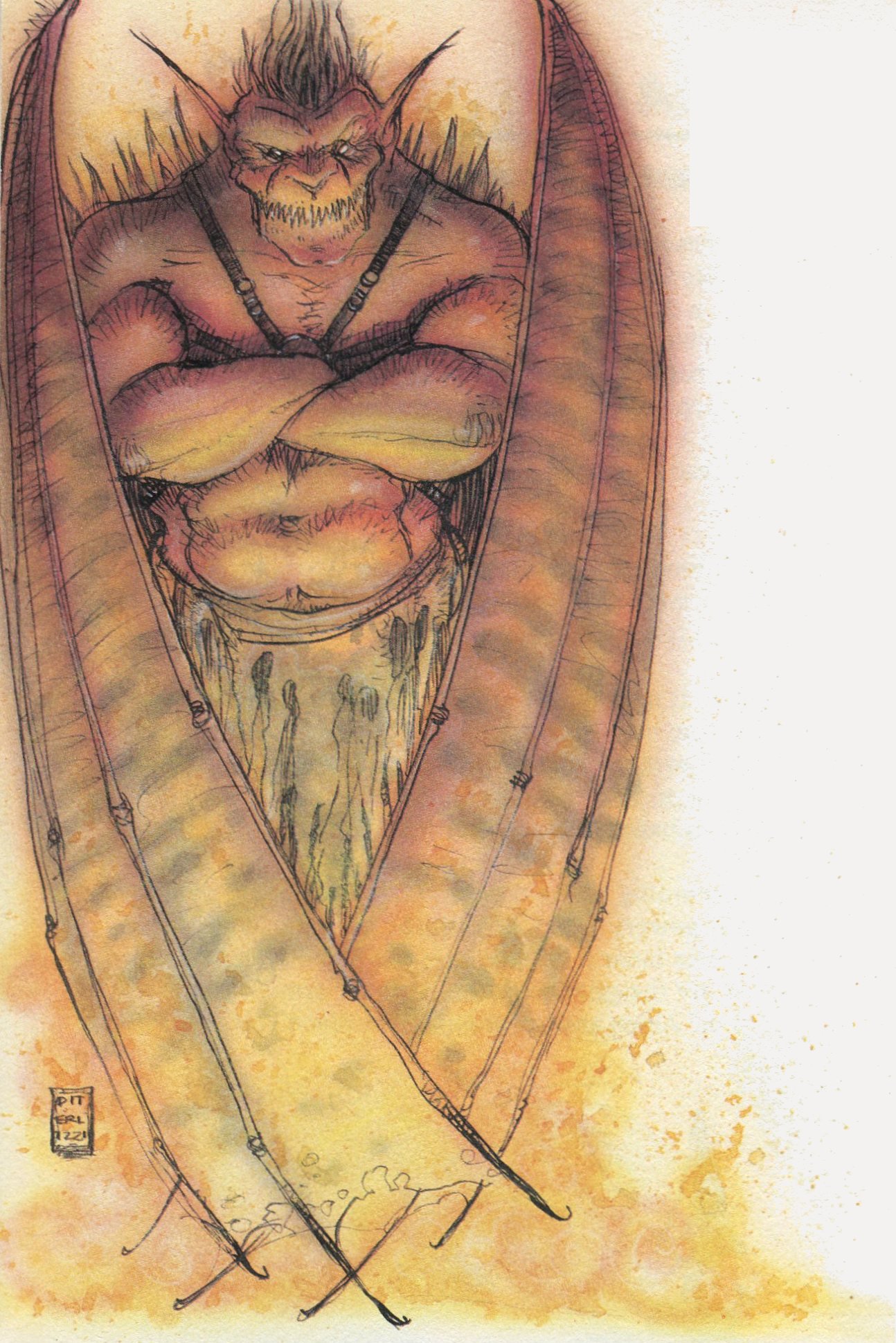
Balor (26000 xp) are the reason the Tanar’ri involvement in the Blood War extends beyond putting up a wall at the edge of the Abyss with a sign that says “Fuck off Baatezu!” They’re basically the Balrog from Fellowship of the Ring, or at least the movie version (if you want to argue about whether the Balrog is just a guy with a big shadow, there’s a thread for that in TBB). They have a Vorpal Sword and a many-tailed whip. A Balor can use the whip to drag enemies into its body flames. Alternatively, a Balor can just punch dudes, which causes enemies to flee in terror if they fail a -6 Spell Save Despite being the most powerful Tanar’ri, a Balor doesn’t get a strength score (so no damage bonus). Balor can use any Symbol spell once a round and can automatically gate other Tanar’ri once an hour. If killed in the Abyss, Balor explode and do 50 damage to everyone within 100 feet (Spell Save for half damage). Like Glabrezu, Balor make pacts with mortals on the Prime Material, performing services in exchange for power. “At least twenty-four Balors are known to exist.”
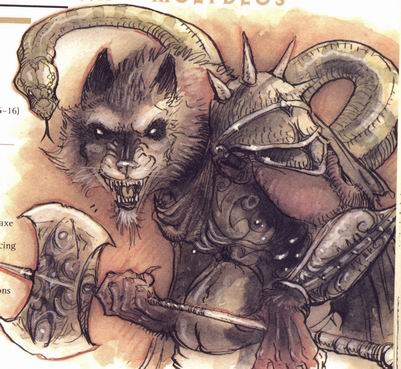
Molyneux is a game developer from the early nineties responsible for classic games like Populous and Dungeon Keeper but is now known for making overblown promises about-wait, sorry, let me start over.
Molydeus (21000 xp) are the only Guardian Tanar’ri. They “enforce the war effort as a sort of political officer.” Because sure, that’s something the plane of Chaotic Evil needs, another bloody policeman. Molydeus uses a +5 great axe that does 2d10 base damage. This axe has the abilities of a Vorpal and Dancing weapon. Its snakehead injects a poison that turns victims into a Manes in 1d6 rounds (Poison Save, Neutralize Poison or Remove Curse can reverse if transformation isn’t complete). Molydeus also get a lot of spell like abilities, including Evard’s Black Tentacles, Improved Invisibility, Polymorph Other, always active True Seeing and Vampiric Touch. Cold-iron weapons are the only type that can damage Molydei (yes that’s the plural). In theory, you can steal a Molydeus’ axe, but this requires leaving the fiend you robbed alive (remember, weapons disappear when owner dies). A Molydeus will not rest until it recovers its axe and horribly kills the thief. A Molydeus are loyal only to the cause of the Blood War, and will
 any True Tanar’ri that strays from this dedication. On the other hand, Molydeus don’t care about non-True Tanar’ri, since they assume they’re just disloyal by nature.
any True Tanar’ri that strays from this dedication. On the other hand, Molydeus don’t care about non-True Tanar’ri, since they assume they’re just disloyal by nature.
Next Time: Remind me why we hired these guys
Yugoloths
Original SA post
Planescape Monstrous Compendium: Yugoloths
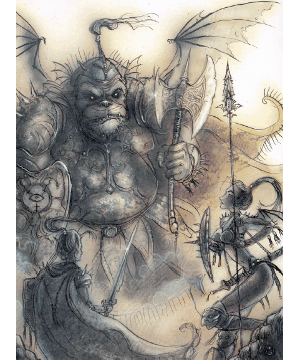
The Yugoloths are the Neutral Evil Fiend race. They can be found throughout the Lower Planes, but mainly inhabit Acheron, Carceri, Gehenna and the Grey Wastes. They act as mercenaries in the Blood War, but they are notoriously treacherous. The intro section opens with a fluff writing describing while Sigil society loves Heroic Rogues (as in the character trope, not the class), the extent to which the Yugoloth do it is not cool. Yugoloth will betray their current employer for greater payment by another. The setting justification for why the rest of the Lower Planes hasn’t set aside a day to wipe out these assholes is because the two sides of the Blood War are afraid that if they don’t hire them then the other side would get an advantage by using them. Also, “battle reports rarely return to Baator or the Abyss” which given the abundance of Telepathy and Teleport without Error on both sides I find kinda dumb.
Like the other major Fiend races, Yugoloth are subdivided into Greater and Lesser.
- Lesser: Dergholoth, Hydroloth, Mezzoloth, Piscoloth, Yagnoloth
- Greater: Arcanaloth, Nycaloth, Ultroloth
The Marraenoloth from the campaign box are Lesser. Greater Yugoloth are officers, while Lesser Yugoloth are the rank-and-file “serve diligently for promises of wealth and power”
Because they are mercenaries, a Yugoloth appears 40% of the time when a mage summons a Lower Planar being. Otherwise he gets a Gehreleth. There is a tome that can greatly facilitate summoning Yugoloth known as the Book of Keeping. The book even contains the personal names of several Greater Yugoloth. Only a Conjurer specialist is able to use the Book of Keeping. Using it is risky even for a skilled Conjurer, but no actual mechanics are provided in the MC. Because of course.
Overheard at a Yugoloth Training Camp posted:
Tanar’ri. Baatezu. The only difference is you collect before the job from the first, and after the job from the last.
All Yugoloth have a common core of spell-like abilities which includes Teleport Without Error, but also Cause Disease, Charm Person and Improved Phantasmal Force. Yugoloth are vulnerable to silver weapons, and actually take double cold damage. Like the Baatezu and Tanar’ri, Yugoloth can try to Gate in their fellows. There is a 25% chance that these reinforcements will betray their comrade, so they are reluctant to use this ability. Yugoloth are described as individually ferocious, but poor formation warriors. In later Planescape books, the Yugoloth become the favorites of the writing group, and are totally controlling the Blood War behind the scenes. But that’ll be discussed when we get to it.
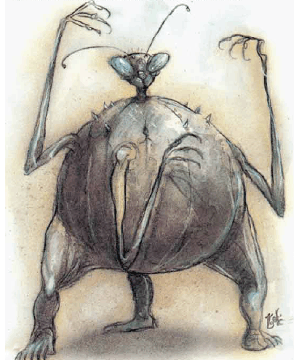
Dergholoth (12000 xp) have 5 arms and 3 legs. They have a 20 Strength (+8 damage) and sometimes carry weapons-a table is provided for randomly rolling a Dergho’s arsenal. If a Dergho hits with 2 claws, it can grab an opponent, gaining +2 on subsequent attacks. A Dergho has the option to parry with weapons rather than attack, which improves its AC by 2. Once per day, can cast a Feeblemind effect on any creature with 7 HD or less that hears it’s chatter. Dergholoths are dumb, and only fight because because stronger ‘loths compel them to. It’s speculated that Ultroloths turn subordinates into Dergholoth as punishment.
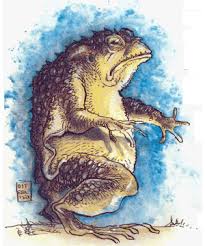
Hydroloth (14000 xp) are used in ambushes and amphibious attacks. The flaps on their arms allow them to glide, and they can swim in the River Styx without losing their memories. Hydros can spit a stream of sleeping piss from their mouth (1d10 damage, poison save or fall asleep for 1d8 rounds). Victims can only be awoken by magical means. Their spell-like abilities include Dimension Door, which they use to gain altitude to glide. A Hydro can also cast Conjure Elemental to summon a 12HD Water Elemental, but this ability only works in the presence of a large body of water. Hydros are respected for their ambushing skills, which they leverage into wealth and prestige. A Hydroloth can also be used for magic item making. Though no specific application is given, the entry says that a live Hydro can bring 2500 gp in some parts of the Prime Material “or even (perhaps) in Sigil.” I cannot begin to describe how dumb that is.
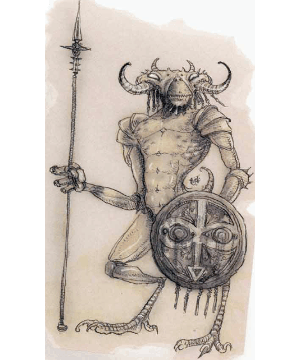
Mezzoloth (21000 xp) are the most common Yugoloth, and serve as the rank-and-file of the ‘loth armies. They have 18/00 Strength, and attack with either claws or weapons. Mezzoloth can use any magical item without penalty “except those restricted by alignment or class”. A solitary Mezzo has a 5% chance to have a magic item. In groups, there is a 10% chance Mezzos have a magic item for every 3 of them. Their spell-like abilities include Cloudkill 1/day and Flame Strike 1/day. They are immune to Charm and Suggestion spells, and cold attacks do normal damage as opposed to double. Mezzoloth are the lowest form of Yugoloth, and they have little motivation when not fighting in mercenary armies. Sages think they were originally brought to Gehenna from some other Plane.
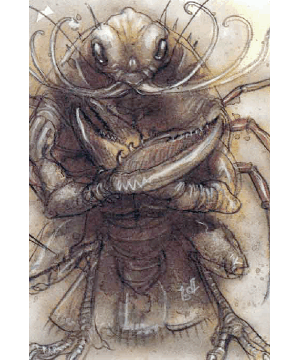
Piscoloth (19000 xp) serve as sergeant in Yugoloth companies. They can never be surprised. A Pisco’s pincer attacks have a chance to sever a limb (nat 20, victim gets Save vs Petrification with bonuses for metal armor and magic enchantments). The mouth tentacles have a poison attack (poison save at -2 or die in six turns unless magically healed. Slowed for 1d6 rounds on save). Their spell-like abilities include Emotion, Meld Into Stone and Phantasmal Killer 2/day. Piscos try to maintain order in the ‘loth armies, and tend to have short life spans either from easily angered superiors or “friendly fire” from abused subordinates. Piscos are one of the few Yugoloth types to cooperate with each other.
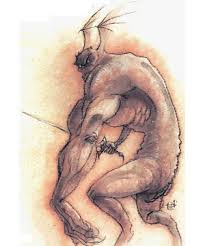
Yagnoloth (20000 xp) are incompetent nobles. Their fiefdoms are propped up by the Ultroloths. Attacks made with their huge arm are treated as 22 Strength and can stun opponents for 2d6 rounds (petrification save to avoid). Yagnos can also use a weapon with their small arm, which has a 30% chance to be magic. 3/day, A Yagno can breath a cloud of acidic gas that does damage and stuns for 1d6 rounds (two separate saves to halve the damage and stun duration). Yagnoloth can feed on an unconscious victim’s life force. Basically energy drain, but also lowers ability scores. Yagnoloths are massive assholes and use their undeserved power to order the execution of higher-station ‘loths and leech off the efforts of the mercenary armies.
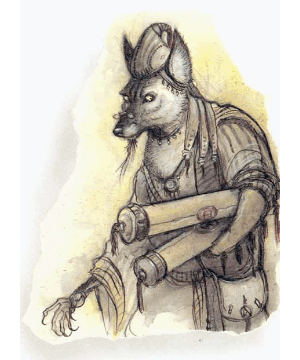
Arcanaloth (20000 xp) are the record-keepers of the ‘loths. Arcana can cast spells as a level 12 mage and have a large suite of spell-like abilities to complement, including Advanced Illusion 1/day, always active Fly, Shape Change to any humanoid form, and more. Physically, their claws have a poison that imposes a cumulative -1 penalty to hit. Arcanaloth are immune to mind-affecting spells, and can only be destroyed if killed in Gehenna. Arcanaloths are responsible for negotiating the contracts between the Baatezu and Tanar’ri, and will openly discuss the other sides offers to raise the stakes. Arcanaloth can speak and write all languages, and are comparatively civilized for fiends.
ecology posted:
An incantation in The Book of keeping describes the creation of a potion that grants success in any venture. The potion requires a shred of flesh from the heart of an arcanaloth. Its efficacy is unknown.
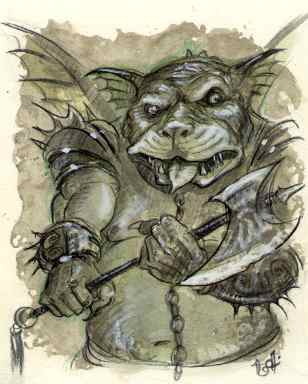
Nycaloth (25000 xp) serve as reporters and observers in the Blood War. They are armed with a two-headed axe that’s enchanted 90% of the time (and has a special enchantment 20% of the time). While their strength score isn’t mentioned, the stats do list a +8 to damage, which corresponds with 20 Str. It also says they get +3 rolling to hit, but whether this has already been included in their THAC0 isn’t given. Alternatively, a Nyca can attack with its fist, which cause an additional 1d6 bleed damage a round. Nyca have a large list of spell-like abilities, including always active Comprehend Languages, Detect Invisibility and Detect Magic. They can also cast Reverse Gravity 1/day and Wraithform 1/day. Nycaloths provide the Arcanaloth the information they need to successfully negotiate contracts. Despite being Greater ‘loths, Nycaloth have relatively low power because their work is profited from by others. They are very bitter and jealous because of this, and have destroyed companies of Mezzos and Derghos in a fit of rage. The Ecology bit goes into Nycaloth breeding habits. I’m not kidding.
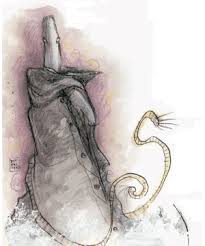
The Ultroloth (26000 xp) are the generals and rulers of the Yugoloth. When fighting personally, they can either use two fists or a weapon, and have a 21 Strength (+9 damage). An Ultro’s weapon is always at least +2, and 40% have special properties. “A very few of these special weapons are extremely powerful; choose their specific abilities, including restrictions or curses.” Anyone who meets an Ultroloth’s gaze must make a spell save or be affected by the Hold Person spell. If the intended victim makes his save, “the ultroloth can use a special form of alter self to appear as a person whom the victim loves or respects.” no further effect is listed, but at least Alter Self is part of the standard ‘loth spell package. Speaking of, Ultros have a yuuuuuge selection of spell-like abilities, including several always-active Detect spells, always active Know Alignment and Pass Without Trace, Geas, Wall of Fire, Firestorm 1/day, Mass Suggestion 1/day, and Symbol (any type) 1/day. Like Balors and Pit Fiends, Ultroloths automatically succeed when they use their Gate ability. Ultroloths control the Yugoloth (and effectively any mercenary company in the Lower Planes) through maintaining an air of mystery force of personality, and knowing everything that happens within their forces. The most infamous Ultroloth is the General of Gehenna. Many Ultroloth seek the General out for the opportunity to serve under him, but no one finds him unless he desires it. Not even the Book of Keeping has the General of Gehenna’s name in it.
Next Time: Virtue is not its only reward
Aasimon
Original SA post
Planescape Monstrous Compendium: Aasimon
The Aasimon are angels. While it seems silly that they would have been renamed because of the satanic scare, I suppose if you’re giving a bunch of blokes in the Outer Planes proper names, you might as well be thorough. Unlike the three fiend races from my previous posts, Aasimon can be of any Good alignment (except Agathinon are specifically Neutral Good
 ). The general info page opens with a story of a drunk scribe describing how he witnessed an army of Baatezu got nuked when it tried to invade Mount Celestia (or Arborea-the writing mixes the two up. Maybe that’s intentional since he’s drunk). Aasimon act as the Proxies to the Powers on the Upper Planes. And just because they are Good-aligned doesn’t mean they can’t be bastards.
). The general info page opens with a story of a drunk scribe describing how he witnessed an army of Baatezu got nuked when it tried to invade Mount Celestia (or Arborea-the writing mixes the two up. Maybe that’s intentional since he’s drunk). Aasimon act as the Proxies to the Powers on the Upper Planes. And just because they are Good-aligned doesn’t mean they can’t be bastards.
Like the fiendish races, Aasimon have a common package of spell-like abilities, including Teleport Without Error. Aasimon can travel freely through the Upper Planes, and can enter the Astral and Prime Material Plane at the behest of a Greater Power. Aasimon have an extra powerful Detect Evil ability that reveals a whole bunch of info about a creature that triggers it. Aasimon get an ability called Celestial Reverence which can make Good creatures love and protect them while weak evil or neutral creatures flee, but they don’t like to use it because free will yadda yadda. They cannot gate others of their kind, but instead are able to send out a distress call that causes the closest enchanted good beings to come to rescue them. Aasimon get several elemental resistances, and are not particularly vulnerable to silver or cold iron weapons.
There are seven types of Aasimon. Agathinon are soldiers and make up the fighting forces of the Upper Planes. The description in the intro section is actually sort of grim:
Aasimon posted:
Warriors also face each other in endless cycles of “holy” wars. Gathering a vast host of agathinon warriors and whipping them into ideological fervor, one pantheon wages devastating campaigns against another, slaughtering thousands, even millions in the name of its particular brand of goodness. Despite their goodness, aasimon can hold a grudge; had feelings still exist between pantheons over holy wars fought thousands of years ago.
 Yeah. In early Planescape books at least, there are plenty of reminders that Good != Nice. The other six types of Aasimon are collectively known as Celestial Stewards, directly serving the Powers of the Upper Planes. They serve the Powers and Messengers and Scouts, and sometimes will render aid to mortal worshippers.
Yeah. In early Planescape books at least, there are plenty of reminders that Good != Nice. The other six types of Aasimon are collectively known as Celestial Stewards, directly serving the Powers of the Upper Planes. They serve the Powers and Messengers and Scouts, and sometimes will render aid to mortal worshippers.
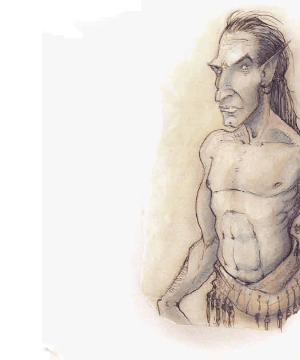 ]
]
As mentioned above, Agathinon (8000 xp) are the soldiers of the Upper Planes. They only appear in their natural on the Upper Planes, but honestly given the proliferation of elf subtypes, I don’t think most mortals in a D&D setting would bat an eye if one appeared. In human form, they fight with non-edged weapons and have the spell ability of a level 7 cleric with a Wisdom of 18. “At any sign of danger, they assume another form.” They get all the attacks and spell-like abilities form, but keep their THAC0, HD, Intelligence “and other statistics.” An Agathinon can also turn into a magic item. This has all the items usual benefits plus the ability to cast any 1st level priest spell at will and turn undead as a 7th level cleric. Evil individuals can not use these items and take damage for trying, but a neutral character can use it as long as it serves the Agathinon’s needs. Agathinon are immune to life-draining spells and abilities, death spells, disintigration and “energy from the Positive Energy Plane” (does that mean they can’t be healed? :confuse:) The fluff section says that when part of an army, Agathinon most often fight in human form, but in special circumstances fight as powerful magical creatures. I would think that any serious battle on the Outer Planes would be a special circumstance.
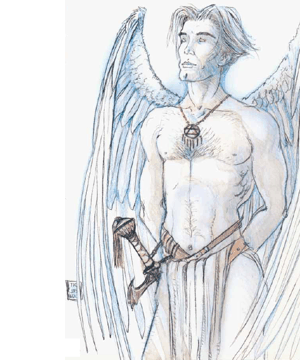
The Deva come in three variety, depending on where in the Multiverse they operate: Astral (15000 xp), Monadic (14000 xp) and Movanic (13000 xp). All Deva have a good selection of support and healing spell-like abilities, and enhanced resistances. Also, Interestingly, the charisma score are given in these entries. Astral Deva (20 Cha) are sent on missions to the Lower Planes. Astral Devas are armed with a +3 Mace of Disruption (3d6 base damage) and can attack twice a round. Anyone hit twice in a round must make a spell save of fall down senseless for 1d12 rounds. Astrals can cast Blade Barrier 1/day and are immune to vacuum, level loss and death spells. Monadic Deva (19 Cha) go on missions to the Inner Planes. They have a strength of 20 and fight with a +3 Rod of Smiting (3d4 base, 2 attacks/round). Monadic are also immune to level loss and death spells. They can cast Hold Monster and Charm Elemental. Movanic Devas (18 Cha) perform missions on the Prime Material and can travel there freely. They can use a variety of weapons, but most often have a +1 Flametongue two-handed sword that they can use twice per round. They can forfeit one or both attacks to parry, which automatically succeeds and even works against magical attacks and even spells that normally always hit. Movanic Deva get the spell-like abilities Spell Turning and Anti-Magic Spell, plus they can cast any Invocation/Evocation spell at will once per day. Movanic Devas get a double-strength Protection from Evil and regenerate 2 hp per round.
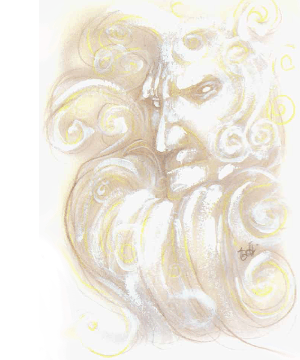
Light Aasimon (10000 xp) serve as familiars to high level worshippers, or sometimes companions on a quest. If a Good- or Neutral-aligned character tries to attack a Light, they must make a Paralyzation Save every round or miss. Light attacks ignore non-magical protection. Lights get a few useful spells (including Hold Person 7/day) and have a long list of spell and effect immunities, but otherwise they’re underwhelming. Details are given for how an adventurer can obtain the assistance of a Light. However, “less than 1,000 Lights exist” so they never stay with someone after one mission.
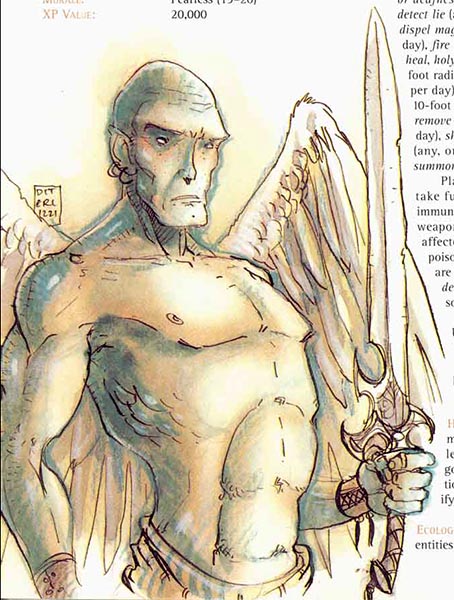
Next we get Planetar (20000 xp). Planetar fight with a +3 Vorpal two-handed sword. They can attack 3 times a round with it, and use it with a 19 Strength (+7 damage). Planetar also get a shit-ton of spell-like abilities, including Limited Wish 1/day, and can cast spells as a 7th level priest with major access to all spheres. Planetar have a bunch of spell immunities and can regenerate 4 hp a round. According to the fluff, characters of at least 12th level on a mission directly related to a good Power have a chance to gain the attention of a Planetar.
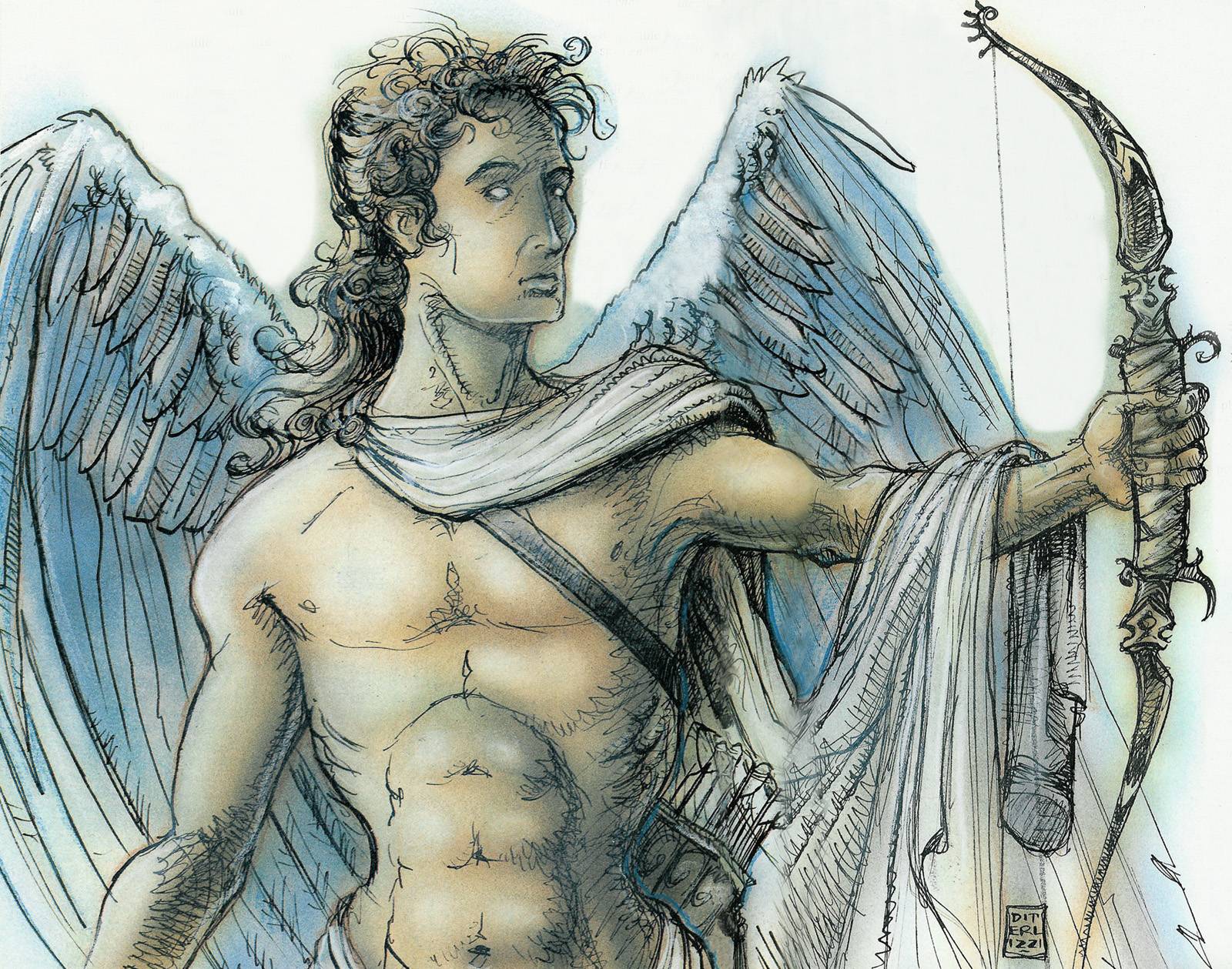
Finally, we abandon all pretense of balance and get the Solar (32000 xp). They get all the immunities and resistances of Planetars and more, and regenerate 7 hp per round. They get a Protection from Evil that also can act as Protection from Normal Missiles and Minor Orb of Invulnerability if the Solar so desires. A Solar can lay on hands to bestow the ability to survive in any environment for up to 100 years. Solar can actually summon Good Magical Beasts at a 75% success chance. On offense, they can attack 4 times a round with a 2d20 +5 Vorpal Dancing Sword. Or they can use a +2 Composite Bow and have a magical quiver that produces an Arrow of Slaying for whatever type of creature the Solar is attacking. Finally, Solars has the spells of a 15th-level Priest with major access to all spheres and even more spell-like abilities than the Planetar, including Wish once per day. The fluff is brief: “Solars are mighty enough to be deities themselves, but they choose to serve rather than have worshipers." Oh and despite having a composite bow no strength score is given for Solars, but really it’s not like they’ll miss it.
So in summary, Good can afford to be dumb, because it’s going to kill the fuck out of you anyway.
Animal Lords and Gehreleths
Original SA post
Planescape Monstrous Compendium: Animal Lords and Gehreleths
These two mega-entries are small, so I’m going to mash them together. Animal Lords (18000 xp) are quasi-powers, and are gods for animals. The Compendium says that the four Animal Lords provided are just examples, and there are in fact Animal Lords for every variety of animal. The
 nitpicker in me wonders if that means an Animal Lord for each species, genus, family or whatever. If I had to rule on it, I’d say that if there’s a stat-block in the MM for it, it gets its own Animal Lord.
nitpicker in me wonders if that means an Animal Lord for each species, genus, family or whatever. If I had to rule on it, I’d say that if there’s a stat-block in the MM for it, it gets its own Animal Lord.
All Animal Lords share common properties. They can take either the form of their respective animal or humanoid form. When appearing as the latter they look vaguely like the animal they’re lording. Their fighting style and form is based on their animal in both forms. Every Animal Lord have a small suite of spell-like abilities and are immune to “charm-related” spells, which is a much more succinct than listing out every different effect like it does with Planetar and Solar. Animal Lords can summon 2d6 animals of their type 3 times per day, and get enhanced senses based on their type. Despite living in the Beastlands, Animals Lords are Neutral and for the most part are concerned only with the affairs of their animals. As with combat, an Animal Lord’s personality is related to what animal they represent.
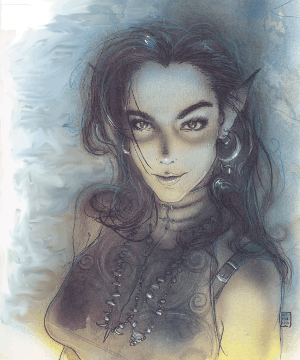
A Cat Lord fights with a Long Sword of Wounding or throws +2 Darts (which get +3 to hit thanks to their dexterity). In animal form, they appear as a black panther and get attacks as such. Cat Lords have the most fluff written about them. Cat Lords are involved with protecting both wild and domestic cats, and their charisma is dependent on how people feel about cats. Which...I’m pretty sure is not how Charisma works even in the turbulent times of 2nd Edition.
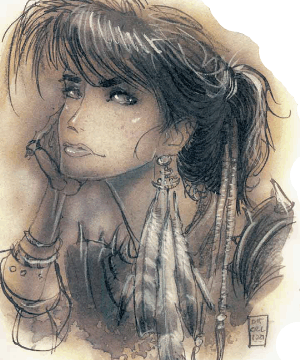
Hawk Lords are really bad at fighting in human form, although they can cast Charm Person 7/day. I suppose that’s balanced by their animal form having flight. Unlike other Animal Lords, Hawk Lords enjoy interacting with humans.
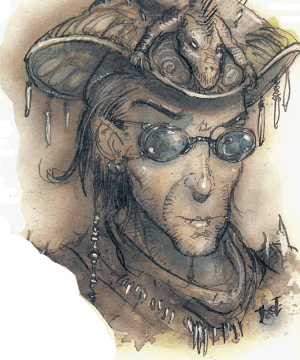
In contrast, Lizard Lords rarely interact with humans. In human form, they rely on a gaze attack that forces a Spell Save a -3 or makes the victim susceptible to the Lizard Lord’s suggestion. In animal form they appear as a giant gila monster or komodo dragon. Despite the former appearance they don’t get poison. Instead, on a natural 20 their bite does double damage and grabs the target, doing normal damage automatically on subsequent turns.
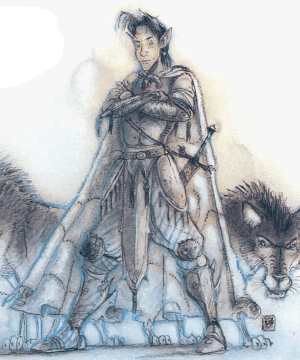
Finally, Wolf Lords always transform into animal form in combat, but it still mentions that they have a poison dagger. In animal form they get two bite attacks per turn and are immune to non-magical weapons.
The main strength of Animal Lords is they have 15HD and a 5 THAC0. By comparison, a Pit Fiend has 13HD and 7 THAC0 (although is that with or without their Strength score factored in?
 ). Honestly, I find Animal Lords uninteresting, especially compared to so many other creatures in this MC. So let’s move on.
). Honestly, I find Animal Lords uninteresting, especially compared to so many other creatures in this MC. So let’s move on.
Gehreleth are a fiendish race native to Carceri. There is a long fluf section that describes the peculiarities of the three different species, but the most important part is that the Gehreleth are followers of a quasi-power named Apomps. Each Gehreleth wears a necklace with an obsidian triangle that supposedly links them to the memory of every other Gehreleth. Gehreleth spawn from the bodies of travellers that died on Carceri. There are exactly 3,333 of each type, although when the Blood War is at its strongest this number doubles. When a Faratsu dies, a new one spawns from a corpse. When a higher tier Gehreleth dies, a lower one gets promoted at random. Like other Fiends, Gehreleth have a chance to summon their brethren.
Jrevis, a Faratsu, to a Clueless Prime before he ate him posted:
Oy! What’re yer lookin’ at, berk? Yer ain’t so sweet yerself!
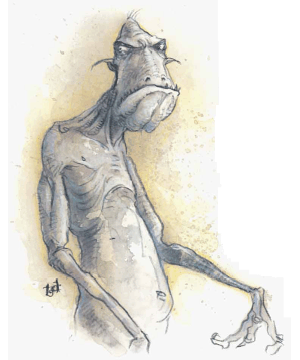
Faratsu (14000 xp) have 19 strength and prefer melee combat to using their spell-like abilities. After six rounds of combat they enter a battle frenzy, which doubles their number of normal attacks and give +2 bonus to attack. Faratsu has slightly sticky skin, so they have a bunch of complex rules on opponents and weapons getting stuck. They have a few spell-like abilities that have limited usefulness and are immune to illusions and phantasms.
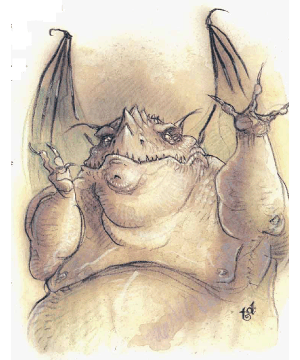
Kelubar (17000 xp) are known as “Slime Gehreleth” because they exude slime that smells awful. Anyone within 30 feet must make a Poison Save or be incapacitated for 1d10 rounds. They have 20 strength. Kelubar’s demon-sweat adds 1d6 poison damage to their melee attacks (save for half). They get a couple of spell-like abilities in addition to the ones listed for the Faratsu, Kelubar can cast Spider Climb (even though they have wings) and Ray of Enfeeblement 1/day.
Talaf the Slimer, coming upon a lost adventurer in Carceri posted:
What’s that I spy in the dark? A lonely little elf? Perhaps I can be of assistance...
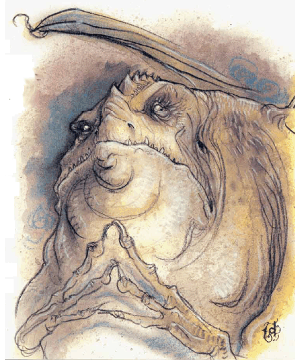
Shator (22000 xp) are the nobility of Carceri (or at least the Gehreleths). They have 21 strength and a +2 on surprise rolls. In addition to claws and bite Shator carry weapons which have a 45% chance of being magical. The text says they prefer magic in combat, although they limited selection: Beguiling (as the Rod of Beguiling) 1/day, Ray of Enfeeblement 3/day, Cloudkill 1/day and Stinking Cloud 3/day.
Gehreleth are strange for a fiend race-they never fight amongst each other. Gehreleth have a class system, despite there being equal numbers of each species. Gehreleth are the summoning stock of the Lower Planes, but they are dangerous because they are vengeful and have a tendency to disobey orders (especially Faratsu).
I like Gehreleth, but I feel they need some reworking of the fluff. I don’t necessarily mind the fluff and mechanics not lining up, because the stats purpose are for the PCs to fight them, not to simulate battles between them. But more than the Yugoloth, Gehreleth feel like a real stretch for why they haven’t been wiped out. The Yugoloth, at least, explains that they play the Baatezu and Tanar’ri against each other. The Gehreleth attack everyone, and with their low numbers, all it takes is one Abyssal Lord to get sick of their bullshit.
Mephits
Original SA post
Planescape Monstrous Companion: Mephits
Mephits (420 xp) are the messengers and go-fors of powerful planar creatures (mostly the evil-inclined ones). They come in 16 variety, each named after an Elemental, Paraelemental or Quasielemental Plane (except Vacumm; the Plane of Steam provides Steam and Mist Mephits). All variety of Mephit fight with their claws and a breath weapon of their type. They also have a 25% chance to Gate Mephits of their type (some Mephits can Gate certain other types too). A Mephit can heal 1 hp per turn when in contact with the appropriate element.
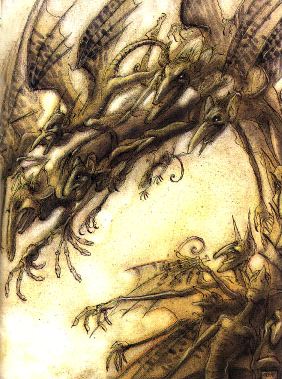
Mephits are sycophantic assholes. To their superiors, they are groveling craven, and highly annoying (although they never betray their creators). Towards weaker creatures or other Mephits, they take up an air of authority and heavily brag up their accomplishments. This can lead to awkward moments for them, as the flavor quotes in the book highlight:
Zaebos, a member of the Dark Eight, upon resuming his true Pit Fiend Form posted:
Yeah, right.Abernathanorial, Ditch Queen, Doom of Dryads, Dearth of Light, Mephit of Darkest Smoke posted:
Foolish human! Know you not that I am feared among mankind? Bow down and cower!
Not surprisingly, Mephits live short, troublesome lives. One cool detail is that they like to smoke pipe tobacco. A dumber detail is that mages on the Lower Planes send Mephits to enemies as “gifts” that imply messages, and the type of message depends on the Mephit sent. For example, sending an Ice Mephit means the recipient is forbidden to enter one’s home. This part makes me think of the part in the Jedi Prince young adult books where the lead Dark Side prophet was crushing colored paintballs to deliver strangely specific messages. The ecology actually provides rules for creating Mephits, although I don’t think the process would work on Lower Planes because of the restrictions to casting on the Outer Planes. Oh and despite tormenting helpless creatures and settling disputes with games of tug-of-demihuman, Mephits are Neutral alignment.
Aside from these generalities, Mephits have personalities based on their type. It’s typical elemental tropes. Air Mephits are fickle and empty headed, Earth Mephits are stubborn and humorless, and so on. It gets more creative with the more obscure types. Radiance Mephits are permanently stoned. Salt Mephits have sarcastic wit. Smoke Mephits are loafers and tell bad jokes about their creator. Each Mephit type has slightly different abilities in combat. Finally, the Ecology section suggests how wizards use Mephits for what are essentially modern household appliances, which I feel doesn’t really fit the setting because it reduces the fantastic parts into really mundane effects.
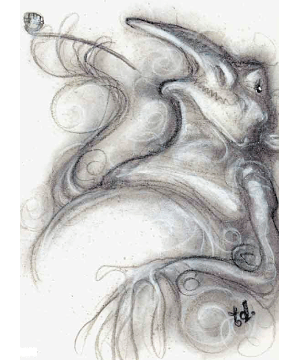
Air Mephits have a single-target breath weapon with a 10 foot range they can use every other round, but needs to fuel it with grit and small debris (1d6 damage). They can cast Blur 1/hour and Gust of Wind 1/day. In a vacuum, Air Mephits die instantly
Smoke Mephits fire a sooty ball every other round that has a 20 foot range and does 1d4 damage and blind for 1d2 round. They can cast Invisibility and Dancing Lights 1/day. On death, they explode doing 1 damage to everyone within 10 feet.
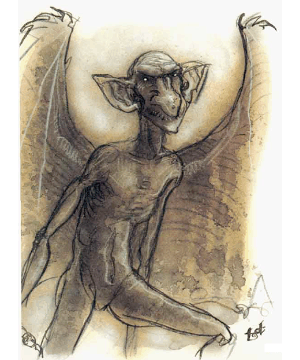
Once per day, an Earth Mephit can grow to L size for 1 turn, increasing their fist damage from 1d4 to 2d6. 3/day, they can spit a rock with 15 foot range. They can use it beyond three times, but doing so causes 2 damage. Passwall and Transmute Wall to Mud instantly destroy Earth Mephit.
An Ooze Mephit’s breath weapon is a Stinking Cloud effect of 10 foot radius. Transmute Mud to Rock instantly destroys them.
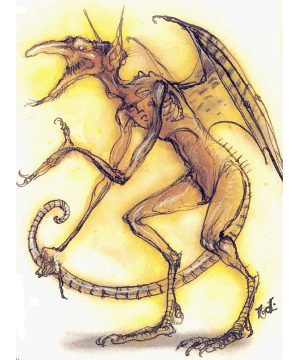
Fire Mephit actually get a proper breath weapon with a 15 range and 1 foot radius, which they can use 3/day. It does 1d8+1 damage (Breath Save for half). Alternatively, the Fire Mephit can breath the fire in a 120 degree out to 5 feet which does 4 damage (no save). Fire Mephit can cast Magic Missile (2 missiles) and Heat Metal 1/day.
Radiant Mephit can cast Color Spray 1/day. They are immune to all spells that affect or work through vision, but they are not allowed to save against mind-affecting spells. Also, “unless directly attacked, they usually become distracted and forget their opponents.”
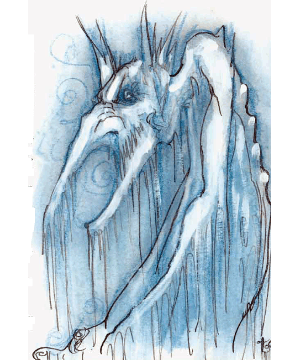
The writers forget to give the range of a Water Mephits breath weapon, which does 2d4 damage for 2 turns (save for half). They are immune to fire, but take double cold damage
An Ice Mephit’s touch imposes a cumulative -1 to hit penalty, up to -3, for 3 turns. They can shoot a volley of ice shards 3/day at one target (1d6, save for half). They are immune to cold, but take full damage from fire and heat.
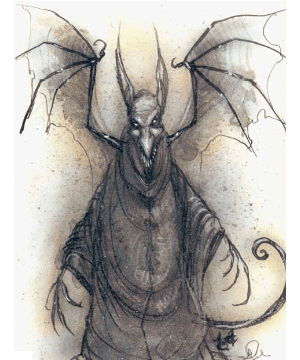
Dust Mephit can create a cloud of dust with a 15 foot radius 3/days. The cloud lowers AC by 4 and imposes a -2 to hit (save to avoid). They take max damage from water or wind attacks.
Both the claw attacks and breath weapon of Salt Mephits are very painful. Aside from the damage, victims must make a Paralyzation Save or be stunned for 1d2 rounds. They can cast Taunt 1/day. Ice Mephit take max damage from water attacks, and even normal water does 1 point of damage per round of contact.
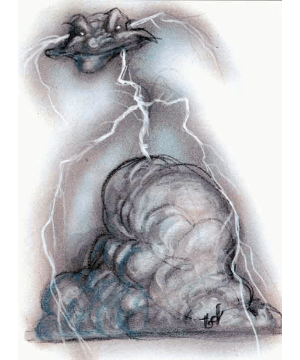
For Lightning Mephits, the book says it works like the Lightning Bolt spell 3/day, but then specifies how it doesn’t work like it (3d6, 1 target only). Attacking a Lightning Mephit with metal non-magical weapons and may shock the attacker (save or 1d3). Lightning’s are instantly destroyed by being doused in liquid (at least 5 gallons). They fully regenerate from contact with an electrical source.
Mineral Mephit have a 10 foot radius Glitterdust as their breath weapon, which they can use 3/day. They can move through stone walls of up to 1 foot. Passwall or Transmute Rock to Mud instantly destroy them.
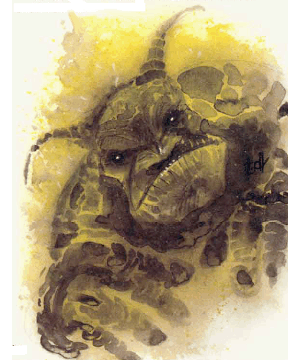
A Magma Mephit has the strongest claw attack (1d8+1 each) and can destroy most non-magical material in 3 rounds. They can fire a blob of lava every 3 rounds for 1d6 damage, 10 range. Magma Mephit can shapechange into a pool of Magma.
Ash Mephit, according to the combat text, cannot claw or bite, but the stat block lists normal attacks anyway. Their breath weapon is a 10’ radius 1d6 (save half), but it costs 1 hp every time they use it. Once per day, an Ash Mephit “can harangue good and neutral creatures with a lengthy recitation of its woes.” This works as Leomund’s Lamentable Belaborment.
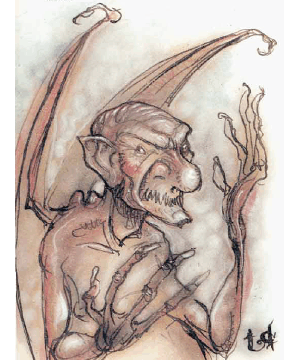
Mist Mephit breath a ball of poison mist every other round, up to 3/day. It does 1d4+1 damage and blinds for 1d4 rounds (Poison Save to avoid). Mist Mephit can cast Wall of Fog and Gaseous Form 1/day.
A Steam Mephit’s claw attacks and breath weapon have a 50% chance to stun a target for 1 round (this effect is cumulative). Their breath weapon can be used every other round, and has 20 foot range and does 1d3. Once per day, a Steam Mephit can create a rainstorm of boiling hot water over a 20x20 area. This does 2d6 damage, no save. Finally, they can cast Putrefy Food and Drink 1/day.
Next time: Frog Drugs
Slaad
Original SA post
Planescape Monstrous Companion: Slaad
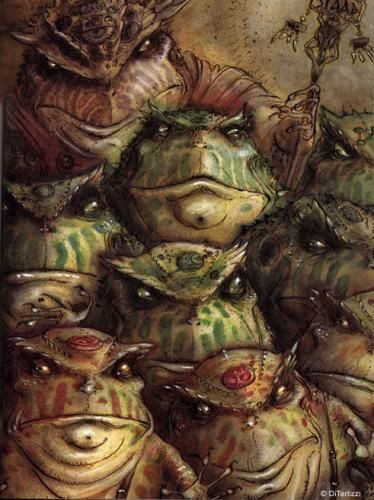
Slaad are the native planar race of Limbo. They scavenge the battlefields of the Blood War, feeding on the dead and using the wounded in their reproductive cycle. They operate in cliques, with the strong ruling as many weaker ones as they can keep track of. Although they want to rule the multiverse, but lack the will to mobilize armies or become involved in the intrigues of “other fiends” (note: Slaadi aren’t fiends). Although they aren’t evil, they are nonetheless pretty nightmarish and are just as likely to wreck your shit as any Tanar’ri. Slaadi have a chance to Gate in others of their kind.
Red Slaad (2000 xp) attack with two claws and a bite (1d4/1d4/2d8). Once a day, a Red Slaad can emit a loud croak that stuns opponents within 20 feet for 2 rounds (Petrification save to avoid). A Red Slaad’s claw attack has a 25% chance of implanting an egg that takes 3 months to gestate. A Blue Slaad hatches and eats the host from the inside.
The Blue Slaad (9000 xp) have more potent claws (2d6) and attack twice with each in a round. Their bite inflicts the equivalent of mummy rot 10% of the time. This is separate from the chance to inflict lycanthropy on wounded and unconscious humanoids that transforms the victim into a Red Slaad over the course of three months. They get the spell-like abilities Hold Person, Passwall, and Telekinesis.
Both the egg and the transformation effect can be detected with Detect Evil, and can be stopped with Cure Disease, Remove Curse, or similar curative magic. To prevent this, Red and Blue Slaadi put victims into temporary camps. Red and Blue Slaadi have an intense rivalry despite their interconnected life cycle, and it’s only through raw instinct that these two groups haven’t Prisoner's Dilemna’d the entire race into extinction.
If a Red or Blue Slaadi’s victim is a powerful human or demi-human (such as a high-level adventurer), then sometimes a Green Slaad (11000 xp). A Green Slaad can polymorph into the human or demi-human that it spawned from. They get a selection of spell-like abilities, the most significant being Delayed Blast Fireball 1/day. The book says that they prefer to use their innate magic or Gating in other Slaadi, even though they can’t Gate with total reliability.
A Green Slaad that lives for about a century will withdraw into the wilderness. Many are never seen again, but some return after one year as a Gray Slaad (15000 xp). Gray Slaad retain the ability to Shapechange into the host they spawned/transformed from, and often wield a magic weapon in this form (“referee’s choice”, which is a really weird term). As a nice nod to their chaotic nature, their list of spell-like abilities says these are “powers they’ve demonstrated”, noting that not all Gray Slaadi posses all the listed powers. Some Grays can enchant an item given the time and materials.
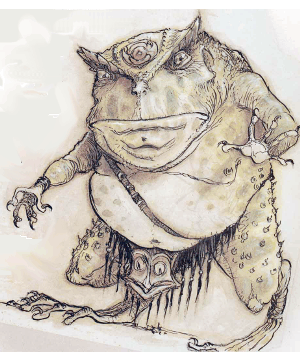
Gray Slaadi are obsessed with learning the secrets to transforming into Death Slaad (22000 xp). At least a half-dozen are known to exist, and they are the closest thing the Slaad have to leaders. A Death Slaad’s claw attacks require those it hit to make a Con check or be stunned for 1d6 rounds. They have the same Shapechange abilities as before but get enhanced stats if appropriate (at least 12 charisma and 18/01 strength). They have even stronger spell-like abilities than Gray Slaad, and they can Gate other Slaad once a turn with a 100% chance of working. Like Grays, Slaad can enchant items.
So those are all the mega-entries in the Monstrous Compendium. I’ll be covering the remaining entries in order of how interesting I find them. If I decide some are too boring to include, that’s just how I roll, bitches. (I will show off the art of course)
Next: The Golden Girls
Night Hags, Larvae, Imps, Quasits, and Nightmares
Original SA post
Planescape Monstrous Companion: Night Hags, Larvae, Imps, Quasits, and Nightmares
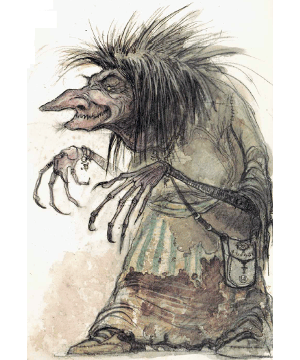
Night Hags (12000 xp) inhabit the Grey Wastes. Practically speaking, they rule the place. They are also a key component in the economy of the Lower Planes.
Night Hags will attack any good creature if they believe they have a chance of winning. Physically, their bite can cause disease on a failed poison save. Magic-wise, they get a decent selection of spell-like abilities, including Ray of Enfeeblement 3/day. Their most potent ability can only affect “selfishly evil” monsters and characters. It’s a Sleep spell that works on up to 12 HD or 12th level (spell save to resist). The hag then strangles the victim and takes its spirit back to the Grey Wastes where it becomes a larvae. Even if the target makes its save will then visit the victim in ethereal form (which it can assume at will, the entry just now mentions) and intrudes on its dreams, riding on the victim’s back until dawn. This permanently drains the victim’s constitution by 1 each night. When the victim dies, the Night Hag takes his or her soul back to the Grey Wastes. The only way to prevent this is to destroy it in either it’s normal or ethereal form. Oh, the Night Hag doesn’t have Planeshift or Teleport Without Error, so how she gets to and from the Grey Wastes is basically DM fiat.
Night Hags rule the Grey Wastes by default. They gather larvae into herds and barter them to the Baatezu and Tanar’ri, though they also sell them to Liches. The fluff section here says the fiends use larvae to create Imps and Quasits, respectively, but their uses expand as the setting evolves. Night Hags see the Multiverse as a place of eternal conflict. They don’t form permanent alliances, although others will seek out their counsel thanks to their “keen minds and perfect memory”. They’ll trade for knowledge, magic items and spirits, but if the other party is weaker, they’ll track them down and turn them into larvae. Night Hags don’t hate any species in particular or even their own kind. That makes them perfect intermediaries on the Lower Planes, and only their aversion to permanent alliances keep Night Hags from having even greater power. Night Hags have a burning desire to know all things, and have founded mortal colleges to that end. “some research projects - even those carried out by the most moral of wizards - have been ultimately found to be financed by hag gold.” Night Hags remember any time they were outwitted, and will spend years plotting revenge. They also remember every kindness shown to them, “but they appear less motivated to repay it.”
Amanitis, a Night Hag haggler posted:
Larvae! Larvae for sale! Nice, fresh larvae...
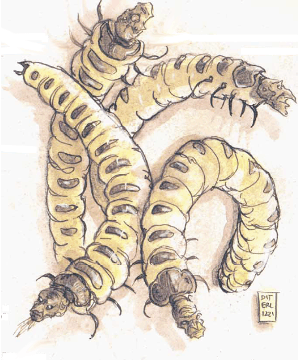
So what are larvae? (35 xp) The monster entry says they are the souls of especially selfish mortals, but this expands to the soul of any NE mortal that wasn’t a devotee of a specific power. The entry opens with an excerpt from an in-setting chronicle of a famed Planar traveller Mordeia the Great. Mordeia describes how her party travelled through the Grey Wastes disguised as a Lich’s court, and met a coven of Night Hag that tried to sell them larvae. The Night Hags demonstrate how they brand larvae, and before leaving Mordeia pinches the branding iron. Fin.
Combat notes are provided for the Larvae, but honestly, that’s not the important part. Larvae are the de facto currency of the major powers in the Lower Planes. Adventurers can use gp to buy the usual goods even here, but if you need to Get Shit Done, it either involves using larvae or trading larvae to someone. Baatezu and Tanar’ri can turn larvae into Imps and Quasits, and these in turn can be promoted into stronger members of their races. Alternatively, larvae can be used to power magic rituals, such as extending a lich’s immortality. The description also drops a plot-hoot about rumors of the Dark Eight gathering a million larvae to power a ritual that’ll destroy the Tanar’ri once and for all.
Putris, a sister to Amanitis posted:
My larvae’s fresher’n her’s. Trade wi’ me an’ I won’ bite yer!
This feels like a good time to talk about Imps and Quasits. In Planescape, they aren’t actually Baatezu and Tanar’ri. In fact they aren’t technically fiends. They serve as familiars for evil wizards and priests, conferring the normal familiar benefits and drawbacks and more (they give 25% magic resistance to their “master”). In both cases the creature makes a contract with its new “master” and gradually takes over their actions. Imp/Quasits have long-term ambitions to become more powerful. They cannot be destroyed outside their home plane, and return after a year and a day. On the planes, they serve as messengers, errand runners, and agents of the Baatezu/Tanar’ri.
All this fluff info comes from the Imp side. The Quasit writing is peak
 “same as imp, but chaotic evil instead”.
“same as imp, but chaotic evil instead”.
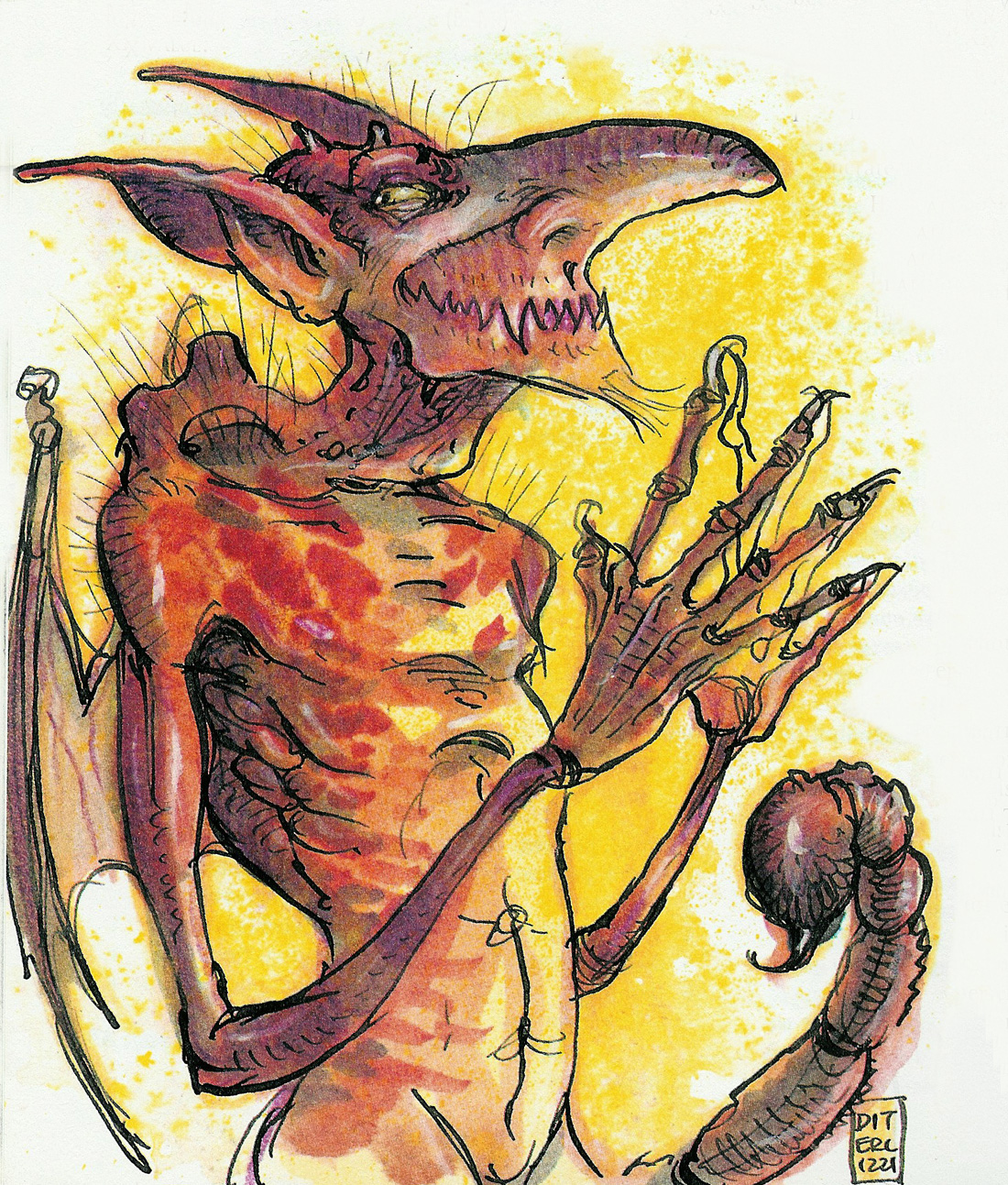
While they serve the same role, they are pretty different in combat. Both can Polymorph Self into two animal forms, and the two have different preferences. Imps (1400 xp) use their stinger to inject an instakill poison (at least it allows a poison save). They get a few spell like abilities, including Suggestion 1/day and Invisible at will.
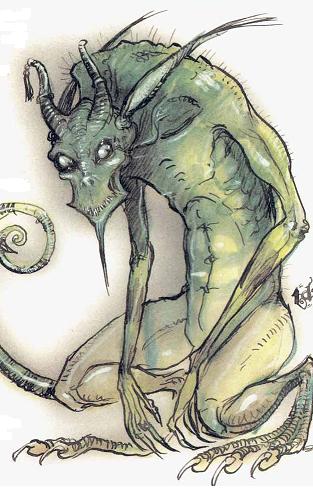
Quasit (2000 xp) have somewhat better base stats but weaker abilities. Their claw attacks impose a cumulative -1 penalty for 2-12 round (poison save to ignore). Quasit have the same spell-like abilities as Imps but instead of Suggestion, 1/day they can cause Fear in a 30 feet radius. Once a week, a Quasit can Commune with the Lower Planes, asking up to 6 questions.
An Imp pondering the merits of its daily summonings posted:
Hmm...17 offerings of employment today. Which to choose? Which to choose?
I suspect that the Imp/Quasit and Larvae monsters were conceived at the same time. In the Ecology section of Larvae, we have this blurb: “Larvae are the sole means for creating imps and quasits. Because imps and quasits later advance to become greater fiends, larvae are the foundation of the population of the Lower Planes.” Which ignores the fact that we were told in the actual Baatezu and Tanar’ri entries that Lemures and Manes form the base-line of their races respectively. However, in Imp ecology, we have in parenthesis, “Speculation, fostered by the imps themselves, has it that fiends evolved from imps.”
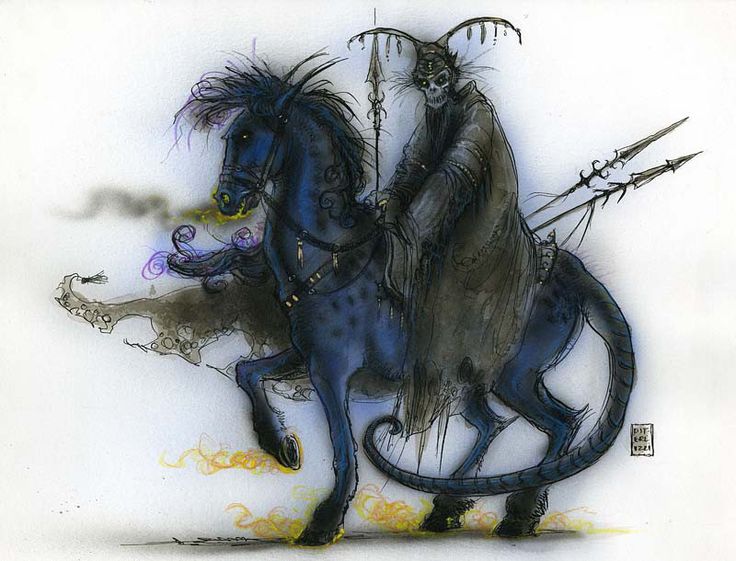
I’ll wrap this post up with the Nightmare (2000 xp), since Night Hags use them as mounts. Aside from kicking and biting enemies, they emit a cloud of noxious vapors that chokes everyone within 10 feet (Paralyzation Save or -2 to hit damage). Also, Nightmare can not only fly, but move freely through the Astral and Ethereal, which make them very useful for bad dudes and dudettes to get around. In the fluff section, it describes how an evil character can gain the services of a Nightmare. Some of the steps and qualifiers are pretty common in 2nd edition for intelligent mounts and evil hirelings. These steps only apply to mortals-fiends and other Lower Planar creatures do their own thing. In the department of tangential setting info, we get this: “Once per year on the plane of the Gray Waste, its denizens meet in a dark and sinister Gloom meet to debate how to spread their will for the next year. Nightmares announce the Gloom meet. For two weeks before the Meet, nightmare frequency changes from very rare to uncommon. Immediately before the meeting, the nightmares herald it by riding the planes in a terrifying charge.” The monster entry concludes with the writing of a wizard that visited a Nightmare gravesite called the Hill of Bones. I give it a 6.5/10 on the Spooky Meter.
Next Time: the Children of Gith
Githyanki and Githzerai (plus Bariaur and Tieflings)
Original SA post
Planescape Monstrous Companion: Githyanki and Githzerai (plus Bariaur and Tieflings)
The Githyanki and Githzerai are two humanoid species who share a common backstory. They were originally humans abducted by Illithids to serve as labour and food. Over the centuries, they secretly built up their power, until one day a woman named Gith led them in rebellion. After they won their freedom, the rebels split into two groups. One group followed Gith to the Astral Plane and became the Githyanki. The other group followed a wizard to Limbo, becoming the Githzerai.
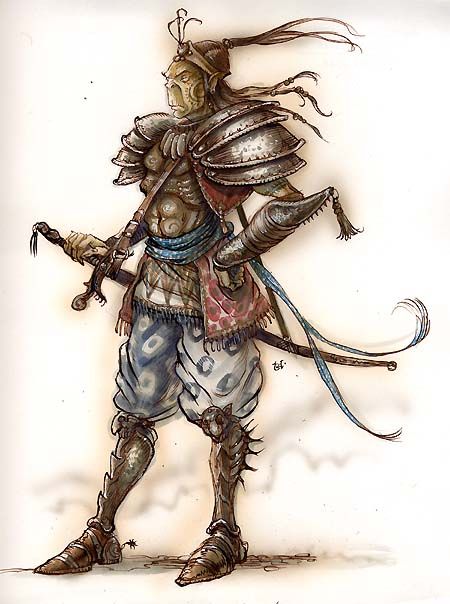
Today, the Githyanki (xp varies) raid the Prime Material and continue their civil war with the Githzerai. The combat section is more about rules for making a raiding party. Githyanki raiders can have the character classes fighter, mage, fighter/mage, illusionist, and knights (i.e. anti-paladins). Githyanki can be equipped with magic arms and armor. Knights often carry a Silver Sword (not to be confused with a sword made of silver), which can cut the cord of astral travellers killing them instantly. If a Githyanki Knight loses his Silver Sword, they’ll go to any length to retrieve it. Individually, Githyanki can Planeshift at will. Also, there’s a stat block for psionic powers, but the character generator doesn’t have a psionic on it and no psionic powers are listed. Finally, when encountered on the Prime Material, they use Red Dragons as mounts, I assume because someone at TSR thought that would be rad (and I approve).
The Githyanki dwell in huge castles on the Astral Plane built on the corpses of dead gods. The ecology and habitat/society section provide detailed information on how the Githyanki survive on the Astral Plane, with weird names for fungus-farmers, magic architects and so on. In addition to their homes, Githyanki also maintain bases on the Prime Material from which they attack Illithids and just cause general mayhem. They are ruled by a lich-queen, who may or may not be the original Gith. Any Githyanki that reaches 12th level in their class are immediately teleported into the presence of the queen and drained of their life force. Despite being evil and ruled over by someone almost as bad as Lolth, the Githyanki never fight amongst each other.
So aside from the soul-sucking Lich Queen I think the Githyanki are pretty cool and I’d use them in a Planescape Campaign. As a side note, this section is more or less verbatim from the 2nd Edition Monster Manual.
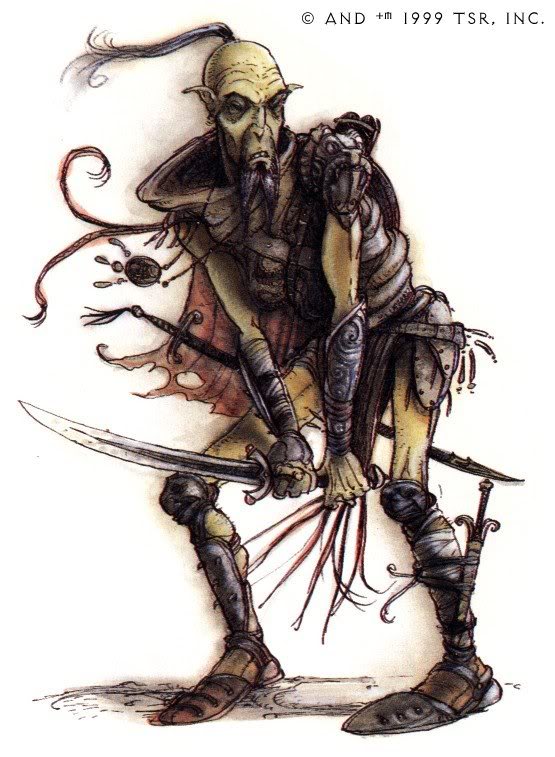
By contrast, the entry for the Githzerai (xp varies) has been adjusted from the MM on account of them now being a PC race. The combat section is stupidly similar to the Githyanki, describing how to put together a group of them. They even have a chance to carry Silver Swords even though they don’t live in the Astral. The monster entry is also full of contradictions. For example, in one part it says that the wizard-god of the Githzerai destroys any wizard that gets above 10th level, but another part says that Githzerai groups can contain a master thief of up to 12th level.
On Limbo, the Githzerai live in cities of 100,000 or more. These are islands of stability in the CN plane. The largest city is the capital, Shraktlor. Like the Githyanki, they have bases on the Prime Material, which they mostly use to monitor the Githyanki and counter their moves if necessary. Besides the Githyanki, the Githzerai organize hunts for Illithids across the Multiverse. In the ecology section, we get this tidbit: “Although human and githzerai are not natural enemies, the two races sometimes battle, in part out of humans' desire to capture a live githzerai for study. To date, no human has.”
Overall, I find the Githzerai entry way too derivative of the Githyanki. Since they are a PC race, they get more work on them throughout the setting’s duration.
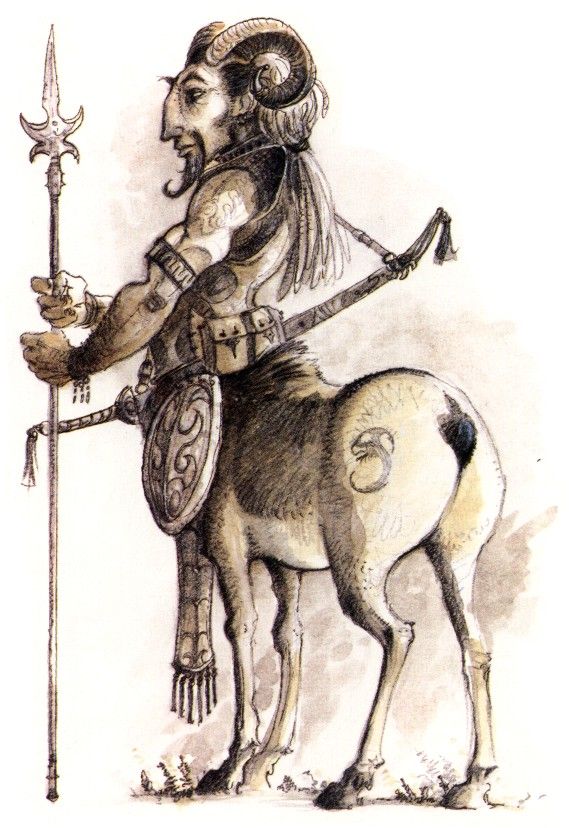
While I’m on the subject of player races, I’ll cover the other two introduced in the campaign box. Bariaur (2000 xp) as listed here fight with a special club that has the same stats as a two-handed sword, can charge attack for 3d6 and a 50% chance to knock down, get 10% magic resistance and a +2 to surprise roll. The sample Bariaur can move between the layers of Ysgard at will.
Bariaur on Ysgard live in flocks 5d4 males, 1d20+10 females,and 1d12-1 young (I’m saddened the goat gender names aren’t used). They are led by a particularly strong or charismatic male. While his rule is absolute, young males may freely challenge them in ritualized combat. I’m going to copy-paste the rest of the Habitat/Society entry because it’s pretty

Habitat/Society posted:
An under-reported aspect of bariaur life is their robust playfulness. They believe that that the two great goods are the advancing of their strong sense of honor and the need to have a good time. The bariaur often meet in shows of friendly rivalry on the great grassy plains of Ysgard. At these festivals they stage singing contests, tell tale tales, and play an intricate game not unlike polo. Human observers often mistake the rivalry for pride or pettiness, and are often completely flabbergasted when, at the end of a festival, the bariaur depart on the friendliest terms.
Even bariaur adventurers on a hard quest may arrange simple contests to remind them of the joy of life. It is a magical moment when a grimly determined bariaur happens on one of his fellows and puts aside his honor-driven quest for a few minutes (or hours) of race and sport. Such events often do them as much good as a night’s sleep. Then they return to their quests.
Nothing saddens a bariaur like learning that a companion is sad. These brave ones fear neither death nor the most monstrous manifestation of the powers of darkness; yet they have been known to journey across the most dangerous planar barriers to visit the sickbed of a valued friend.
Yeah, I think the Bariaur are chill. The ecology section says they travel to other layers of Ysgard in search of grazing, but since the second layer is perpetually on fire and the third is underground, I don’t think they would find it.
One thing this entry has in common with the Githyanki one is a 4th wall-breaking quote. The initial description says that Bariaur are “probably a hardy relative of the centaur”, and on the next page we get this quote:
Gorad Drummerhaven, a noted biologist, upon reading this entry posted:
Related to Centaurs? Hmph!
And while there’s no quote on the Githyanki pages, at the halfway point there’s a big picture of a Githyanki (
Kharzed, a Githyanki Knight dwelling on the Prime Material posted:
You’re halfway there, berk! Don’t stop reading now!
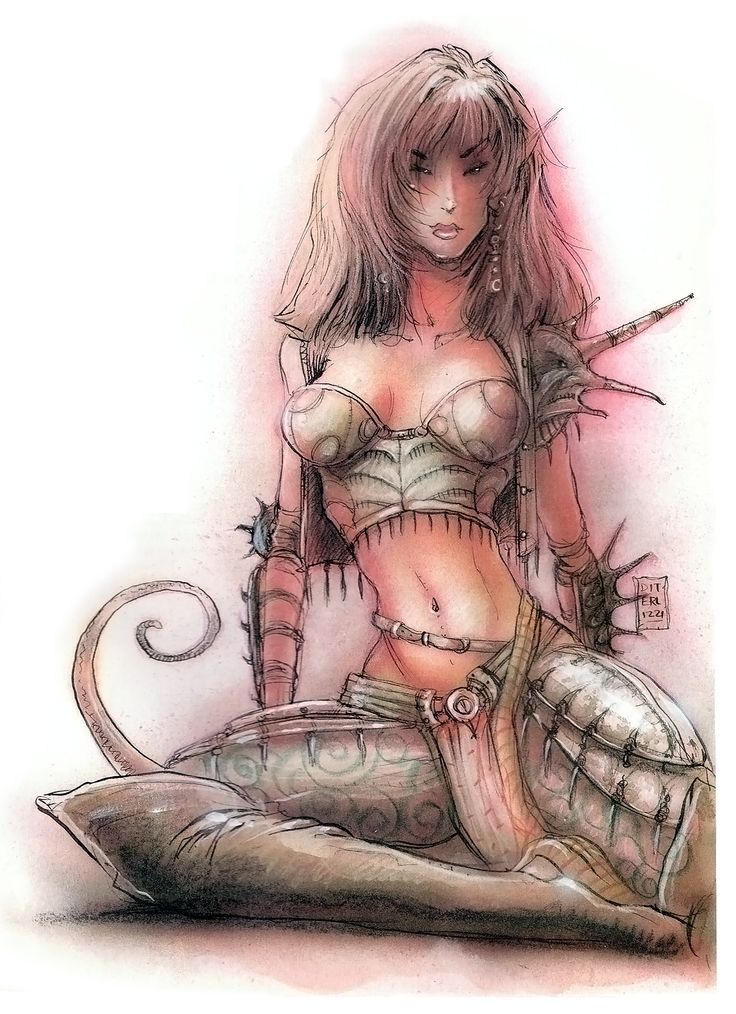
Enough pointless details. Moving on to the final PC race, the Tiefling. (650 xp). Before Aasimar and Gensai are introduced, Tieflings weren’t necessarily the descendants of human-fiend pairings, just a human and “something else”. The combat section is more focused on describing preferred tactics and spell selections than providing a fixed list of attacks and defenses. It’s basically put together the same way the elf and dwarf entries in the MM are written. The habitat/society section reiterates a lot of the stuff from the players section of the Campaign Box, which an emphasis on the orphan mindset (I guess no Tiefling ever was actually raised by their parents). They have astounding self-confidence, a tendency to distrust others, and frequently con-artists. Groups of Tieflings sometimes band together forming informal Thieves Guild.
I was never a big fan of Tieflings, but I don’t dislike them either. They are very nineties. The book seems to swing between saying they’re unfairly persecuted, and that players are right to be distrustful. They aren’t so much a specific minority group but a mashup of every minority stereotype ever, which I guess is the way to do it if you want to have an ostracized downtrodden. Then again, I’m whiter than a snowman at a Donald Trump rally, so I might have a privilege or two to check.
The Prime, not knowing the Tiefling was in a mood to be generous posted:
Say wha-A Tiefling to a Clueless Prime posted:
What’cha wanna bet I can chop your bone-box before you can even open it?
Next Time: We were too lazy to actually write a monster you could use
Hordlings, Mediators, Einheriar and Bebilith
Original SA post
Planescape Monstrous Companion: Hordlings, Mediators, Einheriar and Bebilith
Hey, DMs! Are you tired of having monsters with defined appearances, stats, number of attacks and special abilities? Have felt that your Random Encounter tables weren’t random enough? Ever set up an encounter and thought you needed way, way more to keep track of?
If you said yes, then TSR has the monster for you: the Hordlings! (xp varies). They’ll even toss in two nice men in white coats to take care of you, because you are certifiable!
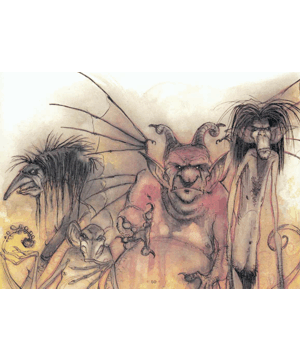
That’s supposed to be the pic of Hordlings in this book, but you wouldn’t realize it because they aren’t on the page for the Hordlings entry. If the drawing looks like a random collection of fiends, well that’s exactly what Hordlings are!

Hordlings are native to the Grey Wastes and make up the majority of the population there. They are technically fiends, but they are hardly mentioned in future Planescape material. I’m not even sure they were even included in 3rd edition. No two Hordlings look the same, so to simulate this, a DM is told to roll twenty-three to twenty-five times on random charts to determine its appearance and combat abilities!

Just...what DM would ever bother with this? This had to be a holdover from 1st Edition. I mean maybe this would be useful if it was presented as a build-your-own fiend race. Unfortunately the highest intelligence Hordlings can have is 10, so the only use they have is for big dumb hordes. And to make things worse, have some poor editing!
Habitat/Society posted:
there are an infinite number of hordlings on the infinite layers of the Abyss. They have no purpose or organization.

The entry says that mages sometimes summon a Hordlings, because the only thing better than summoning a fiend that wants to murder you and/or steal your soul is one whose capabilities are a complete crapshoot. The entry describes a magic device called The Bringer of Doom that can summon hundreds of Hordlings at once. Using it destroys everything in a 100 foot radius including the user, so we’re off to a great start already. There’s a story of an idiot mage using the device, with the results you would expect.
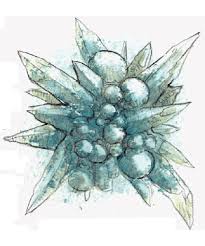
Hordlings are the dumbest thing in this MC, although not the most bullshit thing. That title belongs to Mediators. Mediators are proxies of Neutral Powers. The Mechanus Mediator (no xp) maintain the perfect balance of Mechanus. There are only three of them, but imo just one is too many. They have an unlimited Wish spell which they can only use to maintain the balance of Mechanus. So if they come across a battle, “the mediators can destroy combatants until the sides are equal or even telekinetically stop the battle.” There’s no way to destroy a Mechanus Mediator, since it’ll just use Wish to save itself. Specifically, “Without conscious effort mediators can affect any attacker, no matter where or in what manner the attack is launched. The attacker immediately undergoes an alignment shift to absolute neutral and, therefore, ceases its attack.”
So you know how Planescape is supposed to be about altering reality through the power of belief? Yeeeahh, with this fucker I guess players can forget about doing any of that on Mechanus. Luckily the writers decide to ignore the existence of DM fiat: the Monster, otherwise cool adventures like The Great Modron March would have never happened.
[couldn’t find pic-it’s just a ball]
There is a somewhat less-B.S. variety of Mediator, the Translator Mediator (1400 xp). Translators are the the messengers of the Neutral Powers (and occasionally other powers). They even pulse a yellow light when they have a message. They only fight if attacked, and use a beam that misses only on a hit roll of 1 and stuns a target for 1d12-3 rounds (if 0 or less, the target isn't stunned). Not only are victims stunned, if they are spellcasters they lose all their memorized spells. The next part, I’m going to quote:
Combat posted:
The gods of the Upper Planes take special care of the translators. These beings carry the plans and will of the gods from plane to plane. Therefore, if a translator is attacked while delivering a message, the sending deity always becomes aware of this and sends aid. In such an instance, roll d100. If the result is 99 or less, the deity sends an aasimon servant to help. If the result is 00, roll again. If the second roll is 99 or less, the deity sends ld6+1 aasimon servants. If the result is 00, the deity itself appears. Aid of this type arrives in 1d10 rounds after the translator is attacked.
I...I have no words...
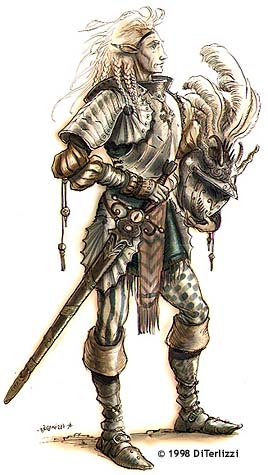
Not the Einheriar pic from the book, but an Aasimar, so close enough
And thankfully, that’s the worst this book has to offer, so the rest is uphill. For example, Einheriar (xp varies) Strictly speaking, Einheriar specifically refer to the dead of Asgard, but over time the term came to mean any humanoid spirit serving the Powers of the Upper Planes as servants or warriors. We get an excerpt from a Norse Saga of how a party of fantasy vikings are saved from being curb-stomped by frost giants by a company of Einheriar. After the battle is won the Einheriar return to the heavens, their numbers greater than when they first appeared.











Einheriar form loose companies that make up the armies of the Upper Planes powers. Individuals have the same class and level they had in life. They get the maximum number of hp for their level, and are equipped with the best arms and armor appropriate to their power. “For instance, einheriar in service to the Great Spirit of the American Indian mythology would not wear plate mail and carry two-handed swords.”
 Einheriar have a 3% chance per level of possessing a mundane magical item. That seems kinda low, but maybe the Powers specifically reward Einheriar-status to PCs playing with stingy DMs. Defensively, Einheriar receive a 5% spell resistance.
Einheriar have a 3% chance per level of possessing a mundane magical item. That seems kinda low, but maybe the Powers specifically reward Einheriar-status to PCs playing with stingy DMs. Defensively, Einheriar receive a 5% spell resistance.
Einheriar don’t have agendas of their own, being wholly devoted to the concerns of their Power. They respect Aasimon and Archons (Archons don’t get introduced until a later supplement) but they act independently of them, taking on lesser missions
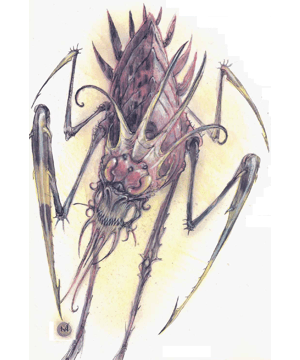
I feel like I need one more write-up to recover from reading and then writing about Mediators, so here are Bebiliths (13000 xp). Bebilith live in the Abyss where hunt Tanar’ri, which is pretty hardcore if you ask me. Like a lot of entries, this one has a short story at the beginning. What I like the most about these is that they do a lot to sell the cosmopolitan nature of Planescape because of the huge variety of names the characters have. In this example, the alchemist Brahmadatta of Ind is trying to make a magic net capable of holding any being. Because this is 2nd Edition, his project required killing magical beings for their organs, in this case a Bebilith’s spinnerets. The story explores logical consequences of this methodology, as Brahmadatta is killed by Bebiliths and his workshop wrecked.
When a Bebilith hits with her forelegs, It has a chance to ruin the target’s shield or armor (40% chance, -10% for each magic bonus). Bebilith have a potent poison bite-Poison Save at -2 or die in 1d4 rounds. If the body isn’t blessed after one turn, it bursts into flames and disintegrates. 4 times a day, Bebilith can create a web (same as Web spell, but permanent and fire will only burn on a 25% chance per round of contact.) Bebilith can Planeshift, and even have the option to pull an opponent with it (Wand Save to resist).
According to some accounts, Bebilith don’t just hunt Tanar’ri, but actively punish them for unfathomable reasons. While there are certainly creatures in The Abyss that could destroy a Bebilith with ease, nothing ever does. Adventurers can even take advantage of their special status by hiding in a Bebilith’s lair. Of course this usually just trades one problem for another. Some have tried illusions of a Bebilith but with mixed results (read: up to your DM).
And just in case you still want to get ahold of their spinnerets, the rules are provided.

Next Time: Everything Else
Let's make a Hordling!
Original SA postKavak posted:
Hordelings sound like fun to roll up but an absolute nightmare to use.
Actually, that's not a bad idea.

Planescape Monstrous Companion:Let's make a Hordling!
Before I begin, I need a name for my Fiend. Since he gave me the idea, in the tradition of L5R I'm naming this monster Oni-no-Buckley
I start by rolling the basic stats for Buckley-AC, base movement rate, hit dice, magic resistance, and size. I roll a d4 five times. My results are 1, 2, 1, 3 and 1. This translates to AC 3, movement 9, HD 6+3 (or 6d8+3), 15% MR, and size S. Our THAC0 is a function of HD, in this case 15. Not a great start for Buckley.
Next I roll for how many limbs Buckley has and what kind of arms are they. I roll a d6 four times. For the arms, I roll a 6-which translates to four arms-and 1-the arms are multi-jointed. On the legs, I get 4-two legs, and 6-telescoping, which adds 50% to the height. 4 arms gives Buckley at least 4 attacks a round, so at least he gets lots of attacks.
Detailing out our limbs as well as other possible extremities, we roll the d6 another four times. The results are 1, 6, 2, and 1. 1 for hands mean they are long, thick-fingered. This has the annotation (g) which is the type of attack that extremity can perform. The 6 for the legs means they are webbed, which means we can swim at our land speed. The 2 for back means it's hunched, so that gives nada (rolling a 5 or 6 indicates wings). Finally the 1 for tail means Buckley gets a prehensile tail. It doesn't have an innate attack, but it can use a weapon.
All Hordlings get a strength bonus. For Buckley, I roll a 3 on a d6, which is a strength of 18/50, or +1 to hit and +3 to damage. I make two d6 rolls for the mouth. The first role is 3, meaning the mouth is Large, and the second roll is 1, indicating protruding tusks (a).
Now we consult the attack table. Our prior rolls gave us (a) and (g). (a) is a tusk attack. Because Buckley has a large mouth, our tusks do 2d4 damage. Mouth attacks don't benefit from strength bonuses. The (g) tells us we punch with our four fists. Each attack is 1d4 plus strength (so 1d4+3 in Buckley's case). In addition, if Buckley hits an enemy twice in a round, it strangles for 2d4+3. I'm guessing that this is an automatic hit and the victim needs to make a strength check to escape, but this doesn't get spelled out.
Our last bit of crunch is to see if Buckley has any special attacks or special defenses. Hordlings have a 10% chance for S.A. and 20% chance for S.D. On a d10, I roll a 0 and 7. But that's no fun so let's give Buckley a break. I roll the d6 twice. For attacks, I roll 3. This gives us a trip attack (as the spell Trip, which I didn't know was a thing). And for defense, my roll is 2, making Buckley immune to fire and acid. Like all Hordlings, Buckley gets 120' infravision.
With all the crunch determined we make our finishing touches. I roll the d6 seven more times: 2, 2, 1, 6, 4, 1 and 2. Two for color is russet-red. Two for head means conical. One on head adornment is bald-but I decide reroll that to 3, or frills. The six for neck indicates that none is apparent. The four on nose means it's long and pointed. The ears are a one, indicating they're long and pointed. And the final two tells us Buckley's overall visage is glaring and menacing.
Bringing all of this together, Buckley is a short but menacing fiend with 4 multi-jointed arms and thick-fingered hands and 2 telescoping legs with webbed feet and a long prehensile tail. It has a hunched back and no neck, making it's frilled, conical head appear to just appear out of its torso. It's long, pointed nose and ears contrasts with it's large mouth and tusks.
- No. Appearing: 1
- Armor Class: 3
- Movement: 9, swimming 9
- Hit Dice: 6+3
- THAC0: 14
- No. of Attacks: 6
- Damage/Attack: 2d4/1d4+3/1d4+3/1d4+3/1d4+3/1d4+3/weapon+3
- Special Attacks: Strangle, Trip
- Special Defense: Immune to Fire and Acid
- Magic Resistance: 15%
- Size: S
- Morale: Unsteady (5-7)
- Experience: I'm sure I could figure it out, but

So...any artgoons want to sketch up our monster?
EDIT
Thuryl posted:
I can't draw to save my life but I felt like doing this anyway
potatocubed posted:
I am also a poor excuse for an artist, but I couldn't resist.
EDIT 2: I counted, and it took 27 rolls to make our monster (plus one reroll). The Hordling entry suggests up to six of them for an encounter.

What I missed
Original SA post
Planescape Monstrous Companion: What I missed
Well I don’t think I’ll ever top making a Hordling, at least in this particular book. So I’m going to quickly go through the remaining entries.
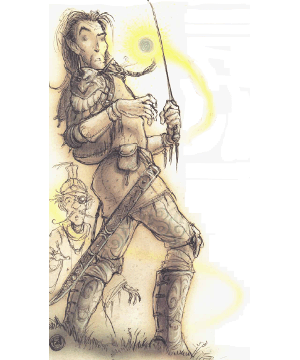
Incarnates are the sapient embodiment of abstract principles. They possess characters and give them benefits as long as they advance the Incarnates principles. Major Incarnates (5000 xp) represent either Good or Evil in general. Minor Incarnates (650 xp) represent specific facets of Good (Hope, Faith, Courage, etc) or Evil (Anger, Envy, Lust, etc). If you encounter one as a player, it’s either because the DM is being really generous or a tremendous dick.
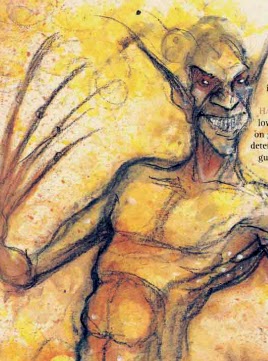
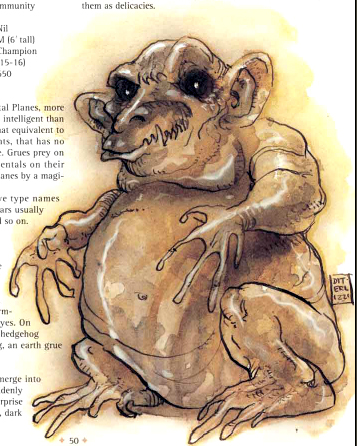
Grue have nothing to do with the Zork adventure games, which makes me sad. Instead they are elemental underlings/vermin. Basically Imps for the Inner Planes. Chaggrin (1400 xp) are the Earth Grues, Harginn (650 xp) are Fire, Ildriss are Air (420 xp) and Varrdig (2000 xp) are Water.
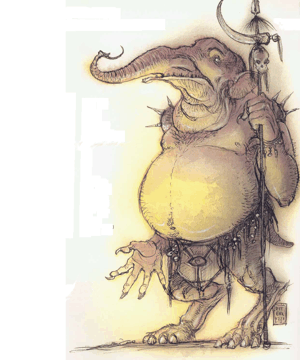
Maelephant (10000 xp) and Per (12000) fill similar roles. The Maelephant are LN bodyguards of Lower Planes higher-ups. I suppose since they aren’t fiends, they’re not part of fiendish politics. Per are tireless LN guardians of portals that lead to the Upper Planes. The most amusing thing from both entries is this quote:
Poratius Tervo (‘P.T.’) Barnum, a Prime new to Sigil posted:
I’m looking for a Maelephant. Anyone see one around?
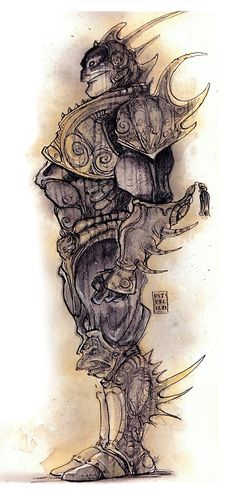
Marut (17000 xp) enforce the will of their Power with single-mindedness. Their punch attack does an insane 8d10 damage.
 They were originally created by the Indian Power Rudra, so they’re geared towards spreading diseases, but nowadays they can work for any Power.
They were originally created by the Indian Power Rudra, so they’re geared towards spreading diseases, but nowadays they can work for any Power.
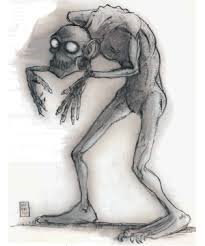
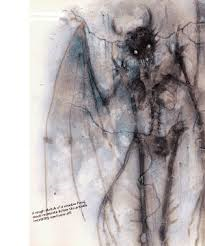
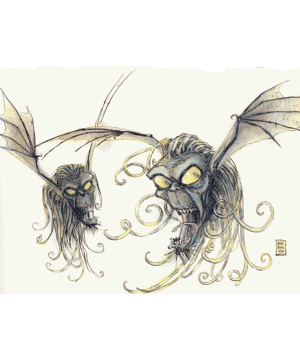
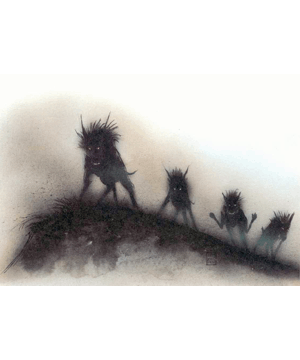
Creatures from the Lower Panes that I skipped over are the Bodak (5000 xp), Shadow Fiend (2000 xp), Vargouille (650 xp) and Yeth Hound (975 xp). Bodak are humanoids that died in the Abyss. They have a death gaze attack and melt in the sun. Shadow Fiends have variable stats depending on how luminous the area they’re in. They can steal men’s souls but making them their slaves is too complicated a matter. Instead they trade the souls with other denizens in the Lower Planes. Vargouille can paralyze victims and then kiss them (presumably they’re humanoid) to make a new Vargouille. There’s another snarky quote about a dumb section of the fluff. The Yeth Hounds are used by the higher-ups of the Lower Planes as hunting dogs. Their baying causes enemies to flee in terror, and they proceed to run them down. The page for them has this amusing quote:
A Changeling to her Elven Foster Parents posted:
He followed me home. Can I keep him please?
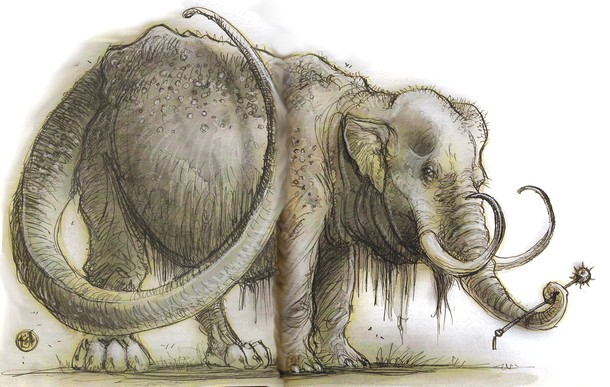
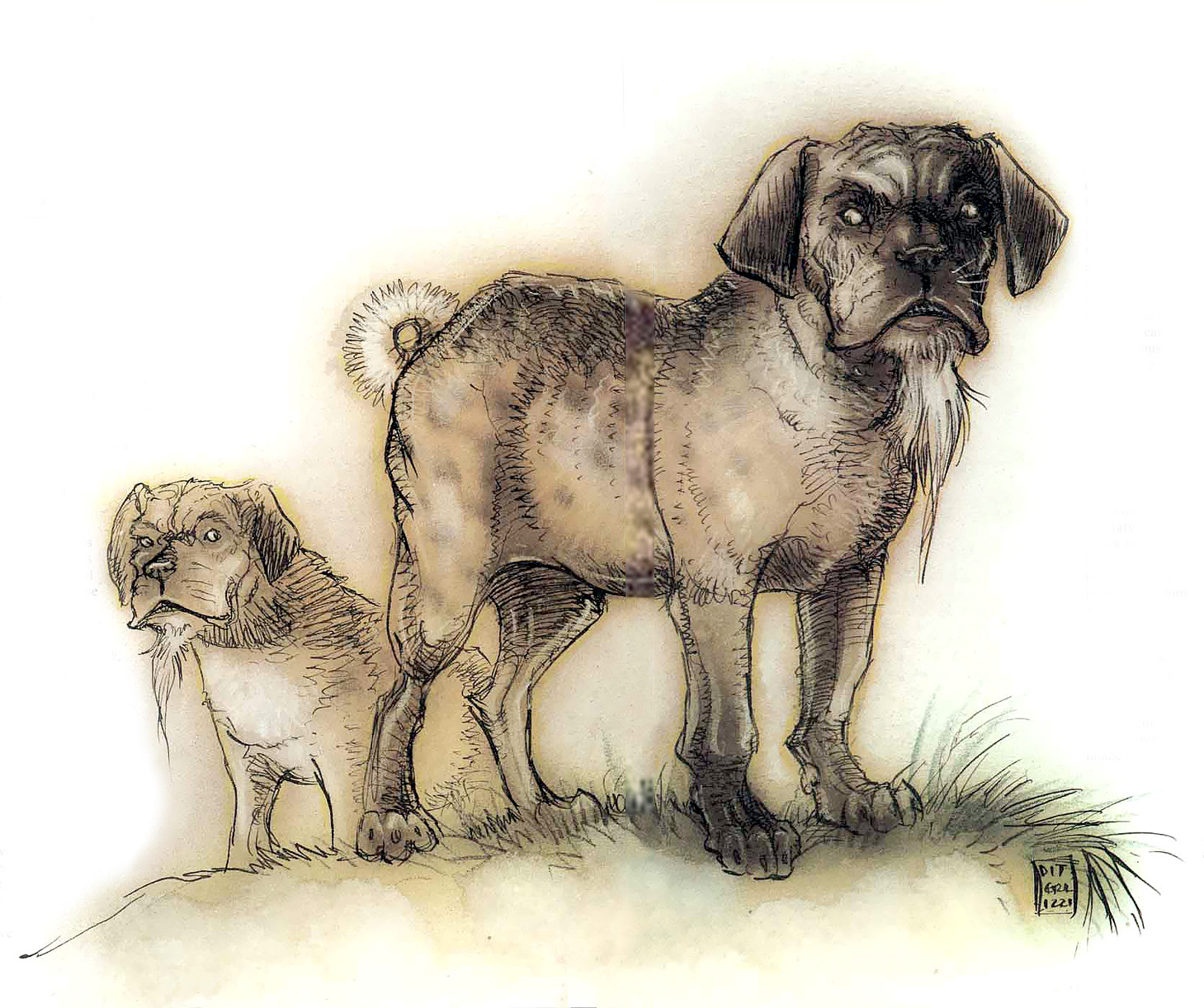
Our final two monsters are from the Upper Planes. As with the mythology they’re based on, the Baku (14000 xp) are magic dream tapirs. Most are Good-aligned, but there are a few Evil ones too. They use Psionics, in case the players and DM want to drive themselves crazy with those. Foo Creatures are former petitioners of Chaotic Good powers that get elevated to Proxy status. They come in two flavors: Dog (6000 xp) and Lion (10000 xp). Good characters may be able to convince them to join or guard them.
And that wraps up the first Planescape Monstrous Compendium. It wasn’t the easiest thing for me to write up because I’d rather discuss the setting than the mechanics. However, rolling up the Hordling alone made it worth it. I’m going to refresh myself on Elminster’s Ecology and decide if I can give it proper justice on this thread. Special thanks to Thuryl and potatocubed for the drawings.
